#Polished Concrete Market in Europe
Text
Acidic Colloidal Silica Market May Set New Growth Story

The Latest research coverage on Acidic Colloidal Silica Market provides a detailed overview and accurate market size. The study is designed considering current and historical trends, market development and business strategies taken up by leaders and new industry players entering the market. Furthermore, study includes an in-depth analysis of global and regional markets along with country level market size breakdown to identify potential gaps and opportunities to better investigate market status, development activity, value and growth patterns.
Access Sample Report + All Related Graphs & Charts @: https://www.advancemarketanalytics.com/sample-report/40909-global-acidic-colloidal-silica-market
Major & Emerging Players in Acidic Colloidal Silica Market:-
Nissan Chemicals (Japan), FUSO CHEMICAL CO., LTD (Japan), Bee Chems (India), Grace (United States), Nouryon (Netherlands), Guangdong Well-Silicasol (China), Remet (United States), Nyacol (United States), Qingdao Haiyang Chemical (China), Evonik (Germany).
The Acidic Colloidal Silica Market Study by AMA Research gives an essential tool and source to Industry stakeholders to figure out the market and other fundamental technicalities, covering growth, opportunities, competitive scenarios, and key trends in the Acidic Colloidal Silica market.
Acidic Colloidal Silica is also known as Silica sol, is a stable suspension of spherical silicon dioxide nanoparticles in liquid, that is hydroxylated on the surface. It is found in almost all industrial sectors. Their preparation happens in a multi-step process where an alkali-silicate solution is partially neutralized, leading to the formation of silica nuclei. pH is reduced below so it starts to show acidic properties. With increasing manufacturing activities all over the world, this essential chemical has risen in demand.
The titled segments and sub-section of the market are illuminated below: by Application (Papermaking, Nanomedicine, Binders, Silicon Wafers, Catalysts, Ceramic Coatings, Others), Distribution Channel (Online, Offline), Form (Powder, Liquid)
Market Trends:
Surging Use of Acidic Colloidal Silica as a Strength-Enhancing Additive to Plastics, Mortar, and Concrete
Rise as an Ingredient in Scratch Resistant Coatings
Opportunities:
Application of Acidic Colloidal Silica is Increasing in Construction Sector
Rising Demand from Emerging Economies
Market Drivers:
Extensive Demand as a Rheological Additive in Personal Care Products to Control Flowability
Increasing Role in Electronics Industry as a Polishing Agent
Challenges:
Decreasing Margins Due to Steep Competition in Acidic Colloidal Silica
Enquire for customization in Report @: https://www.advancemarketanalytics.com/enquiry-before-buy/40909-global-acidic-colloidal-silica-market
Some Point of Table of Content:
Chapter One: Report Overview
Chapter Two: Global Market Growth Trends
Chapter Three: Value Chain of Acidic Colloidal Silica Market
Chapter Four: Players Profiles
Chapter Five: Global Acidic Colloidal Silica Market Analysis by Regions
Chapter Six: North America Acidic Colloidal Silica Market Analysis by Countries
Chapter Seven: Europe Acidic Colloidal Silica Market Analysis by Countries
Chapter Eight: Asia-Pacific Acidic Colloidal Silica Market Analysis by Countries
Chapter Nine: Middle East and Africa Acidic Colloidal Silica Market Analysis by Countries
Chapter Ten: South America Acidic Colloidal Silica Market Analysis by Countries
Chapter Eleven: Global Acidic Colloidal Silica Market Segment by Types
Chapter Twelve: Global Acidic Colloidal Silica Market Segment by Applications
What are the market factors that are explained in the Acidic Colloidal Silica Market report?
– Key Strategic Developments: Strategic developments of the market, comprising R&D, new product launch, M&A, agreements, collaborations, partnerships, joint ventures, and regional growth of the leading competitors.
– Key Market Features: Including revenue, price, capacity, capacity utilization rate, gross, production, production rate, consumption, import/export, supply/demand, cost, market share, CAGR, and gross margin.– Analytical Tools: The analytical tools such as Porter’s five forces analysis, SWOT analysis, feasibility study, and investment return analysis have been used to analyze the growth of the key players operating in the market.
Buy This Exclusive Research Here: https://www.advancemarketanalytics.com/buy-now?format=1&report=40909
Definitively, this report will give you an unmistakable perspective on every single reality of the market without a need to allude to some other research report or an information source. Our report will give all of you the realities about the past, present, and eventual fate of the concerned Market.
Thanks for reading this article; you can also get individual chapter wise section or region wise report version like North America, Europe or Asia.
Contact US :
Craig Francis (PR & Marketing Manager)
AMA Research & Media LLP
Unit No. 429, Parsonage Road Edison, NJ
New Jersey USA – 08837
Phone: +1 201 565 3262, +44 161 818 8166
[email protected]
#Global Acidic Colloidal Silica Market#Acidic Colloidal Silica Market Demand#Acidic Colloidal Silica Market Trends#Acidic Colloidal Silica Market Analysis#Acidic Colloidal Silica Market Growth#Acidic Colloidal Silica Market Share#Acidic Colloidal Silica Market Forecast#Acidic Colloidal Silica Market Challenges
0 notes
Text
Japan Calcined Petroleum Coke Market 2023 | Pointing to Capture Largest Growth - 2030
https://www.prosebox.net/entry/1593538/europe-voice-over-internet-protocol-market-2029-new-research-report/https://www.prosebox.net/entry/1593543/usa-aerospace-hose-market-leading-countries-landscape-analysis-amp-application/https://www.prosebox.net/entry/1593546/europe-non-public-security-service-market-2023-regions-type-amp-application-2029/https://www.prosebox.net/entry/1593551/usa-scratch-proof-glass-market-2023-top-trendssegments-analysis-2029/https://www.prosebox.net/entry/1593562/europe-content-collaboration-platforms-ccp-market-2023-development-growth-trends-2029/https://www.prosebox.net/entry/1593566/usa-data-and-analytics-service-market-2023-latest-trends-with-advancement/https://www.prosebox.net/entry/1593570/europe-digital-marketing-analytics-market-is-expected-to-grow-at-an-active-cagr/https://www.prosebox.net/entry/1593572/usa-sodium-malate-market-size-2023-shares-growth-cost-structures/https://www.prosebox.net/entry/1593573/europe-connected-toys-by-interacting-device-market-2023-growth-trends-size-share-2029/https://www.prosebox.net/entry/1593575/usa-wifi-home-gateway-market-share-size-trends-amp-growth-2023-to-2029/https://www.prosebox.net/entry/1593578/europe-concrete-polishing-equipment-market-to-witness-astonishing-growth/https://www.prosebox.net/entry/1593584/europe-marine-boiler-burner-industry-statistics-market-analysis-2029/https://www.prosebox.net/entry/1593586/europe-commercial-amp-industrial-security-service-market-2023-data-analysis-amp-brief-review/https://www.prosebox.net/entry/1593589/europe-hydraulic-notcher-market-2023-projected-industry-growths-to-2029/https://www.prosebox.net/entry/1593591/usa-calendered-polylactic-acid-market-2023-new-study-report-2029/https://www.prosebox.net/entry/1593594/europe-precision-forestry-market-future-demand-market-analysis-2029/https://www.prosebox.net/entry/1593601/europe-low-foam-surfactants-market-overview-demand-size-analysis-2029/https://www.prosebox.net/entry/1593670/europe-pyramid-soundproof-cotton-market-2023-new-comprehensive-study-by-key-players/https://www.prosebox.net/entry/1593671/europe-mechanical-control-valves-market-2029-new-research-report/https://www.prosebox.net/entry/1593672/usa-automotive-fuel-pulsation-damper-market-leading-countries-landscape-analysis-amp-application/https://www.prosebox.net/entry/1593673/europe-hospital-viewing-windows-market-2023-regions-type-amp-application-2029/https://www.prosebox.net/entry/1593674/usa-public-space-floodlights-market-2023-top-trendssegments-analysis-2029/https://www.prosebox.net/entry/1593676/europe-outdoor-screen-market-2023-development-growth-trends-2029/https://www.prosebox.net/entry/1593677/usa-corporate-volunteering-platform-market-2023-latest-trends-with-advancement/https://www.prosebox.net/entry/1593678/europe-automatic-tracking-cameras-market-is-expected-to-grow-at-an-active-cagr/https://www.prosebox.net/entry/1593679/usa-price-comparison-websites-pcws-market-size-2023-shares-growth-cost-structures/https://www.prosebox.net/entry/1593680/europe-vehicle-cooling-fans-market-2023-growth-trends-size-share-2029/https://www.prosebox.net/entry/1593681/usa-rotary-shakers-market-share-size-trends-amp-growth-2023-to-2029/https://www.prosebox.net/entry/1593682/europe-portable-wheel-jack-market-to-witness-astonishing-growth/https://www.prosebox.net/entry/1593708/europe-beverage-processing-polymers-industry-statistics-market-analysis-2029/
0 notes
Text
0 notes
Text
Decorative Concrete Market Research Observes Strong CAGR Demand and Development by 2028
The decorative concrete market is estimated to grow exponentially through 2028 driven by surging demand for aesthetic, modern, and durable architectural designs in the product. In addition, rising disposable income, coupled with growing focus on environmentally friendly construction and building materials to reduce overall greenhouse gas emissions, is projected to further augment industry outlook over the forecast period.
Recently, key players in the sector have been investing in including more sustainable products in their offerings to cater to rising climate consciousness among consumers, thereby enhancing overall market dynamics. For instance, in January 2022, HeidelbergCement unveiled a suite of sustainable concrete portfolio under its sustainable concrete brand, EcoCrete. The sustainable decorative concretes offer CO2 reduction within a range of 30-66%. In March 2022, the company also launched a LEILAC 2 (Low Emissions Intensity Lime & Cement) carbon capture initiative with the aim of capturing 20% of carbon emissions, nearly 100,000 tons, annually by 2025.
Get sample copy of this research report @ https://www.gminsights.com/request-sample/detail/3689
The global decorative concrete market has been classified into product, application, end-user, and region. Based on product, the market has been further fragmented into stamped, exposed, engraved, stained, polished, and others.

The stamped segment is expected to grow at approximately 6.4% CAGR between 2022 and 2028. Stamped concrete is available in a variety of design patterns and offers customization options for enhanced visual appeal with conventional as well as personalized designs, which is set to augment product growth through the review timeline.
The decorative concrete market share from the stained segment is anticipated to exhibit around 5.3% CAGR with respect to volume over the study timeframe. Over the forecast period, stained concrete consumption is estimated to increase due to surging demand for patios, commercial roads, parking lots, driveways, and other commercial spaces, such as offices, restaurants, breweries, retail stores, schools and so forth.
Stained concrete floors are widely used in indoor settings for their various benefits like durability, higher flexibility and eco-friendliness. Moreover, the process allows layering colors for a dramatic effect with variegated or marbled effects in light of the current home decor and architectural trends backed by increasing expenditure on renovation activities by consumers. Surging consumer interest in stained concrete floors is foreseen to positively influence segment development.
Request for customization @ https://www.gminsights.com/roc/3689
In terms of region, the Middle East & Africa decorative concrete industry is slated to witness substantial growth at about 5% CAGR in terms of revenue from 2022 to 2028. Rapidly escalating project development initiatives focused on long-term advancements in the transportation and tourism infrastructures are primed to promote product adoption in the MEA region.
Moreover, the Middle East & Africa (MENA) region is observing a massive shift towards public transport services with mounting investments to boost public transport and infrastructure projects. The region has also emerged as a lucrative landscape for sustainability-focused mobility services, which is speculated to boost regional decorative concrete market development in the future.
Table of Contents (ToC) of the report:
Chapter 1 Methodology & Scope
1.1 Scope & definitions
1.2 Methodology & forecast parameters
1.3 Region-wise COVID-19 impact analysis
1.3.1 North America
1.3.2 Europe
1.3.3 Asia Pacific
1.3.4 Latin America
1.3.5 Middle East & Africa
1.4 Regional Trends
1.5 Data Sources
1.5.1 Secondary
1.5.2 Primary
Chapter 2 Executive Summary
2.1 Global Decorative Concrete industry 360° synopsis, 2018 – 2028
2.2 Business trends
2.3 Product trends
2.4 Application trends
2.5 End-user trends
2.6 Regional trends
Browse complete Table of Contents (ToC) of this research report @ https://www.gminsights.com/toc/detail/decorative-concrete-market
HVAC & Construction Research Reports
Paint Rollers Market
Windows and Doors Market
Outdoor Furniture Market
About Global Market Insights:
Global Market Insights, Inc., headquartered in Delaware, U.S., is a global market research and consulting service provider; offering syndicated and custom research reports along with growth consulting services. Our business intelligence and industry research reports offer clients with penetrative insights and actionable market data specially designed and presented to aid strategic decision making. These exhaustive reports are designed via a proprietary research methodology and are available for key industries such as chemicals, advanced materials, technology, renewable energy and biotechnology.
Contact Us:
Aashit Tiwari
Corporate Sales, USA
Global Market Insights Inc.
Toll Free: 1-888-689-0688
USA: +1-302-846-7766
Europe: +44-742-759-8484
APAC: +65-3129-7718
Email: [email protected]
#Decorative Concrete Market Analysis#Decorative Concrete Market by Type#Decorative Concrete Market Share#Decorative Concrete Market Development
0 notes
Text
Polished Concrete Market Share Register A Strong Growth Of Acceleration During to 2028 | BASF SE, 3M Company
Polished Concrete Market 𝐑𝐞𝐬𝐞𝐚𝐫𝐜𝐡 𝐑𝐞𝐩𝐨𝐫𝐭 𝟐𝟎𝟐𝟐 𝐢𝐬 𝐜𝐚𝐫𝐞𝐟𝐮𝐥𝐥𝐲 𝐜𝐨𝐧𝐝𝐮𝐜𝐭𝐞𝐝 𝐟𝐨𝐫 𝐭𝐡𝐞 𝐢𝐧𝐝𝐮𝐬𝐭𝐫𝐲 𝐢𝐧 𝐚 𝐪𝐮𝐚𝐥𝐢𝐭𝐚𝐭𝐢𝐯𝐞 𝐚𝐧𝐝 quantitative 𝐰𝐚𝐲 𝐭𝐨 𝐞𝐧𝐬𝐮𝐫𝐞 𝐚 𝐬𝐮𝐜𝐜𝐞𝐬𝐬𝐟𝐮𝐥 𝐨𝐮𝐭𝐜𝐨𝐦𝐞 of the Polished ConcreteMarket. In addition to identifying, analyzing, and estimating new trends, this research report also examines key industry drivers, challenges, and opportunities in addition to evaluating competitors, geographical areas, types, and applications. Understanding the competitive landscape is crucial for determining the product improvements that are needed. Industries can securely make decisions about their production and marketing strategy since they can obtain comprehensive insights from a Polished Concretereport.
𝐀 𝐬𝐚𝐦𝐩𝐥𝐞 𝐫𝐞𝐩𝐨𝐫𝐭 𝐜𝐚𝐧 𝐛𝐞 𝐯𝐢𝐞𝐰𝐞𝐝 𝐛𝐲 𝐯𝐢𝐬𝐢𝐭𝐢𝐧𝐠 (𝐔𝐬𝐞 𝐂𝐨𝐫𝐩𝐨𝐫𝐚𝐭𝐞 𝐞𝐌𝐚𝐢𝐥 𝐈𝐃 𝐭𝐨 𝐆𝐞𝐭 𝐇𝐢𝐠𝐡𝐞𝐫 𝐏𝐫𝐢𝐨𝐫𝐢𝐭𝐲) 𝐚𝐭:
𝐂𝐨𝐦𝐩𝐞𝐭𝐢𝐭𝐢𝐯𝐞 𝐥𝐚𝐧𝐝𝐬𝐜𝐚𝐩𝐞: BASF SE, 3M Company, Sika AG, The Sherwin Williams Company, PPG Industries Inc., UltraTech Cement Limited, Boral Limited, dmf concrete, Pasadena Concreteworks, Inc., Charlottes Concrete, Fairfax Concrete, BGSB, Polished Concrete Systems Inc., The Euclid Chemical Company, Vexcon Chemicals, Inc., TSIAC International, Craft Polished Concrete, Envision Polished Concrete, Danek Flooring, Inc., Metric Concrete Construction & Design Inc.
𝐌𝐚𝐫𝐤𝐞𝐭 𝐒𝐞𝐠𝐦𝐞𝐧𝐭𝐚𝐭𝐢𝐨𝐧: 𝐁𝐲 𝐓𝐲𝐩𝐞
Densifier
Sealer & Crack Filler
Conditioner
𝐌𝐚𝐫𝐤𝐞𝐭 𝐒𝐞𝐠𝐦𝐞𝐧𝐭𝐚𝐭𝐢𝐨𝐧: 𝐁𝐲 𝐀𝐩𝐩𝐥𝐢𝐜𝐚𝐭𝐢𝐨𝐧
Residential
Non-Residential
By Region
North America, US, Canada, Latin America, Brazil, Mexico, Rest of Latin America, Western Europe, Germany, UK, France, Spain, Italy, Benelux, Nordic, Rest of Western Europe, Eastern Europe, Russia, Poland, Rest of Eastern Europe, Asia Pacific, China, Japan, India, South Korea, Australia, ASEAN (Indonesia, Vietnam, Malaysia, etc.), Rest of Asia Pacific, Middle East & Africa, GCC, South Africa, Turkey and Rest of the Middle East & Africa.
Key Highlights
• The report provides analysis of current global Polished Concretemarket landscape.
• The report explores the most likely scenarios of the pandemic that are going to impact the Polished Concreteindustry in long-term.
• The report does a detailed analysis studying how the global market is changing.
• The report looks at how the global Polished Concretemarket is shifting, the target market which have biggest opportunities, and trends on horizon that may impact your business directly or indirectly.
• The report highlights the key challenges, risk that you may face in near term as well as highlights opportunities.
Explore Full Report with Detailed TOC Here:
𝐓𝐚𝐛𝐥𝐞 𝐎𝐟 𝐂𝐨𝐧𝐭𝐞𝐧𝐭:
1. Polished ConcreteMarket Introduction
1.1. Definition
1.2. Research Scope
2. Executive Summary
2.1. Key Findings by Major Segments
2.2. Top strategies by Major Players
3. Global Polished ConcreteMarket Overview
3.1. Polished ConcreteMarket Dynamics
3.1.1. Drivers
3.1.2. Opportunities
3.1.3. Restraints
3.1.4. Challenges
3.2. COVID-19 Impact Analysis in Global Polished ConcreteMarket
3.3. PESTLE Analysis
3.4. Opportunity Map Analysis
3.5. PORTER’S Five Forces Analysis
3.6. Market Competition Scenario Analysis
3.7. Product Life Cycle Analysis
3.8. Manufacturer Intensity Map
3.9. Major Companies sales by Value & Volume
𝐂𝐨𝐧𝐭𝐢𝐧𝐮𝐞.
Complete Growth Report Is Available (Including the Full TOC, Tables and Figures, Graphs as Well As Chart):
About Exactitude Consultancy
Exactitude Consultancy is a market research & consulting services firm which helps its client to address their most pressing strategic and business challenges. Our market research helps clients to address critical business challenges and also helps make optimized business decisions with our fact-based research insights, market intelligence, and accurate data. Contact us for your special interest research needs at [email protected] and we will get in touch with you within 24hrs and help you find the market research report you need.
Website: https://exactitudeconsultancy.com/
Irfan Tamboli
Contact: +91-7507-07-8687
0 notes
Text
Polished Concrete Market to Register Substantial Expansion by 2025
The Global Polished Concrete Market size is projected to grow from USD 2.2 billion in 2020 to USD 3.0 billion by 2025, at a Compound Annual Growth Rate (CAGR) of 5.6% during the forecast year.
Browse 135 market data Tables and 52 Figures spread through 161 Pages and in-depth TOC on "Polished Concrete Market by Type (Densifier, Sealer & Crack Filler, Conditioner), Method (Dry, Wet), Construction Type (New Construction, Renovation), End-use Sector (Residential, Non-residential), and Region - Global Forecast to 2025"
In terms of value & volume, densifier is estimated to lead the polished concrete market in 2019.
Densifiers, by type, accounted for the largest market share in the polished concrete market. The growth of the densifier segment can be attributed to the benefits it offers, such as protection to the concrete flooring system against chemical attack, staining, permeable fluids, wear, and degradation. The densifier is widely preferred and demanded for the concrete polishing, and its demand is expected to accelerate during the forecast period, with the increase in the demand from the non- residential sectors, globally.
Dry segment is estimated to be the largest segment in the polished concrete market in 2019.
Dry, by method, accounted for the greatest demand for polished concrete in 2019, in terms of value and volume. Furthermore, dry segment is projected to be the fastest-growing method for the polished concrete, by 2025, in terms of value as well as volume. The high demand can be attributed to the higher shine and durability it offers to the polished concrete floors. For the dry concrete polishing method, the surface of the concrete is ground using commercial-scale polishing machines. Each stage of the process requires a different abrasive polishing disk, often incorporating diamond grit, with coarser textures for earlier stages and finer ones to get the final shine.
New construction segment to dominate the polished concrete market in 2019.
New construction, by construction type, accounted for the largest demand for polished concrete in 2019, in terms of value and volume. Furthermore, new construction is projected to be the fastest-growing segment for the polished concrete, by 2025, in terms of value as well as volume. Many manufacturers have promoted use of polished concrete as a green movement as it can provide them to achieve LEED ratings for their organization. This can be attributed to its high reflectivity, neutral impact on indoor air quality and longer lifespan. This in turn, boosts the demand for polished concrete for newly installed flooring systems of residential as well as non-residential buildings.
Request Report Sample @ https://www.marketsandmarkets.com/requestsampleNew.asp?id=28587676
Expansions accounted for the largest share of all the strategic developments that took place in the polished concrete market between 2017 and 2020. Key players such as BASF SE (Germany), and SIKA AG (Switzerland), adopted these strategies to enhance their market presence and strengthen their manufacturing and distribution capabilities in the polished concrete market.
PPG Industries is a global manufacturer and supplier of specialty materials, paints, optical products, and coatings. It caters to a large customer base in various markets, such as consumer products, industrial, construction, and transportation. The company is financially and strategically well placed and has a strong customer base. It gives increasing importance to R&D activities. It focuses on expanding its existing distribution network to serve customers better. Further, it focuses on innovating and expanding its existing product portfolio for industrial and performance coatings business segments.
BASF SE is one of the leading chemical companies with a portfolio that provides chemicals, plastics, performance products, and crop protection products to the oil and gas industry. It has a broad product portfolio, which has encouraged sustained investment in new product developments. The immense strength of the company in R&D activities and expertise in construction and specialty chemical applications are the major factors that are projected to encourage its growth in the next five years.
Read More Information At https://www.marketsandmarkets.com/PressReleases/polished-concrete.asp
About MarketsandMarkets™
MarketsandMarkets™ provides quantified B2B research on 30,000 high growth niche opportunities/threats which will impact 70% to 80% of worldwide companies’ revenues. Currently servicing 7500 customers worldwide including 80% of global Fortune 1000 companies as clients. Almost 75,000 top officers across eight industries worldwide approach MarketsandMarkets™ for their painpoints around revenues decisions.
MarketsandMarkets’s flagship competitive intelligence and market research platform, "Knowledgestore" connects over 200,000 markets and entire value chains for deeper understanding of the unmet insights along with market sizing and forecasts of niche markets.
Contact MarketsandMarkets™:
Mr. Ashish Mehra
MarketsandMarkets™ INC.
630 Dundee Road
Suite 430
Northbrook, IL 60062
USA: 1-888-600-6441
#Polished Concrete Market#Polished Concrete#Polished Concrete Market Growth#Polished Concrete Market Size#Polished Concrete Market Trends#Polished Concrete Industry#Polished Concrete Market Insights#Polished Concrete Market Driver#Polished Concrete Market Forecast#Polished Concrete Market Analysis#Polished Concrete Market in Europe#Polished Concrete Market Region#Concrete
0 notes
Link
In the United States, the major flashpoint is brutalism, a post-war style that marries imposing concrete-and-steel design with stripped-down functionalism. Left-wingers darkly warn of the alt-right “infiltrating” architecture twitter under the guise of criticizing brutalist buildings. Others defend brutalism as a symbol of our lapsed commitment to public housing and economic justice.
Though brutalism is defended on both aesthetic and political grounds, the two arguments are difficult to reconcile. To a certain type of critic, brutalism represents “heroic architecture,” the realization of an individual designer’s vision in concrete and steel. Mid-century pioneers of brutalism like Le Corbusier and Ernő Goldfinger were minor celebrities. Le Corbusier’s architectural vision was uncompromisingly individualistic, unmoored from tradition or conventional ideas about form and beauty. It is no accident that Howard Roark, the fictional protagonist of Ayn Rand’s The Fountainhead, was also an iconoclastic architect. (Roark’s aesthetic sensibilities were closer to Frank Lloyd Wright than Le Corbusier, and the Swiss architect probably would have bridled at Roark’s politics, but the parallels between the two are unmissable.)
To a few intellectuals, brutalist buildings are heroic achievements, but the public has never warmed to them. When Naples’ notorious Gomorrah housing project was recently torn down, the loudest naysayers were professional architects. Actual residents had long complained about the buildings’ conditions. But if you’re not willing to defend the aesthetics of brutalism, ideology will suffice. So says today’s leftist journal Jacobin, trumpeting “Save Our Brutalism,” and lauding the great mid-century brutalist buildings as potent symbols of our now-forgotten commitment to equality.
Defending brutalist buildings on ideological grounds only highlights the divide between design and the lived experience of a building’s residents. As James C. Scott points out in Seeing Like a State, there is a profound gulf between the God’s-eye view of architects and policy-makers and the ground-level view of actual inhabitants, who have to live with brutalism’s unforgiving sterility. From the air or from a distance, Oscar Niemeyer’s vision of Brasilia is a striking achievement. To the city’s inhabitants, however, the Le Corbusier-inspired design is artificial and alienating. Brutalism proposed to strip buildings down to their barest functions, yet it fails at the basic task of providing a welcoming, visually-appealing space for residents and passers-by.
Ascribing a single ideological message to a diffuse architectural movement is also mistaken. Perhaps Jacobin subscribers equate brutalism with public housing, but the meaning is more sinister in Eastern Europe. The tiered design of the Gomorrah housing projects bears a marked resemblance to the resorts built for Communist apparatchiks on the shores of the Baltic Sea. Your average Latvian is more likely to associate these buildings with Soviet-era repression and mismanagement than left-wing nostrums about equality. Enver Hoxha’s Albania produced some striking examples of brutalist architecture. Hoxha, not coincidentally, was a notorious tyrant.
Design fads come and go and political sensibilities change, but the technocratic, top-down worldview that undergirds brutalism persists. In 2011, the Dutch celebrity architect Rem Koolhass was quite open about his preference for “the generic city” over architecture rooted in local culture or history:
The traditional city is very much occupied by rules and codes of behavior. But the generic city is free of established patterns and expectations. These are cities that make no demands and, consequently, create freedom. Some 80 percent of the population of a city like Dubai consists of immigrants, while in Amsterdam it is 40 percent. I believe that it’s easier for these demographic groups to walk through Dubai, Singapore or HafenCity than through beautiful medieval city centers. For these people, (the latter) exude nothing but exclusion and rejection. In an age of mass immigration, a mass similarity of cities might just be inevitable. These cities function like airports in which the same shops are always in the same places. Everything is defined by function, and nothing by history. This can also be liberating.
Technocrats once spoke the language of socialism and central planning; Koolhass and his ilk are more likely invoke markets, openness, and globalization. But the underlying impulse is the same: Society can be cataloged, organized, and ultimately shaped from the top down through the design of its cities and buildings. Beauty, tradition, and culture are secondary considerations.
Even if we dismiss brutalism as a fad perpetrated by blinkered technocrats and egotistical architects, ugly buildings expose ugly truths. Pervasive ugliness seems to impose an unconscious psychic tax on the great mass of people, even if most have no interest in the finer points of architecture or design. So why have we lost the ability to construct beautiful buildings? There are no easy ideological answers. Socialism may have birthed brutalism, but capitalism has given us barren strip malls, cookie-cutter exurbs, and Koolhaas’s “generic city.”
By contrast, Notre Dame de Paris was a communal undertaking, built by generations of craftsmen and artisans. The names of several of its earliest architects are lost to history. Crude historical revivalism is also unsatisfying. Warsaw’s ersatz Old Town, rebuilt in the wake of World War II, is an impressive testament to Polish national will, but it lacks the authentic charm of Krakow’s beautifully-preserved historic district. Budapest’s Fisherman’s Bastion, a restored medieval structure, pales in comparison to the city’s old baroque neighborhoods. And Huawei’s “European” campus, plopped down in the middle of Southern China, is the architectural equivalent of the uncanny valley: The closer it hews to historic European buildings, the faker it looks and feels.
171 notes
·
View notes
Text
Burnout Syndrome: Mark Fisher From the Future

In the wake of Burnout Syndrome (work caused stress/alienation) becoming mainstream, it’s worth reflecting on Mark Fisher's writings connecting mental health to the post-Fordist workplace.
For history to become what it always was, symbolism must be established in the future. The effects of neoliberalism and the post-Fordist workplace have only recently started to gain a kind of general consensus. Although symbolism can be initiated prior to an event (fiction, cyberpunk, etc.), for thinkers and media to reflect in the face of an overabundance of events is to start the first step of glancing back at the ‘vanishing’¹ moment whose symbolism will only emerge concretely in the future as what ‘will have been’². While it’s unclear where the late Mark Fisher is on this spectrum of concrete reflection on the symbolism and historicity of our time (he quotes many who have speculated before him), his thoughts on the neoliberal induced mental health crisis is a good spot to jump into as The World Health Organization’s updated definition of Burnout Syndrome (linking cynicism and distance from work to the workplace) in the International Classification of Diseases — ICD-11 — is making its way around the major news outlets. Although this is only a small step towards connecting mental health to the post-Fordist workplace, to understand the case being made by Fisher and how it relates to the real (burnout syndrome becoming mainstream as being connected to the workplace), it’d be beneficial to first walk through the differences between Fordism and post-Fordism.
For Fisher, a good example highlighting the differences between fordism and post-fordism is the differences between the gangster movies of Francis Ford Coppola and Martin Scorsese (between 1971-1990) compared to more contemporary gangster movies (Fisher uses Heat as an example). The ideology evolves from the ‘families with links to the Old Country’ to the ‘rootless crews’ prepared to abandon everything at a moments notice. The ‘old fashioned’ ideology prioritizes certain characteristics like family relations, respect, and religion, while the ‘newer’ ones cut through all of this to survive most efficiently. Fisher highlights the new ideology by quoting Neil McCauley in Michael Mann’s 1995 film Heat: “Don’t let yourself get attached to anything you are not willing to walk out on in 30 seconds flat if you feel the heat around the corner.” The ‘traditional’ gangster’s way of life is challenged in the new field where “Family ties are unsustainable in these conditions…” Fisher goes on:
Like any group of share-holders, McCauley's crew is held together by the prospect of future revenue; any other bonds are optional extras, almost certainly dangerous. Their arrangement is temporary, pragmatic and lateral - they know that they are interchangeable machine parts, that there are no guarantees, that nothing lasts. Compared to this, the goodfellas seem like sedentary sentimentalists, rooted in dying communities, doomed territories.
This ‘no long term’ is echoed in the post-fordist career models in which jobs are increasingly more and more temporary. The long term hierarchical fordist model “obligation, trustworthiness, commitment - are precisely those which are held to be obsolete in the new capitalism…” Jobs no longer promise a hierarchical ladder to climb over decades, but a day to day struggle to maintain income. If the gangs held on to permanence, they’d be quickly confronted with the wave of individuals whose only permanence is the lack thereof. The connection to family is then challenged: “The situation of the family in post-Fordist capitalism is contradictory, in precisely the way that traditional Marxism expected: capitalism requires the family (as an essential means of reproducing and caring for labor power; as a salve for the psychic wounds inflicted by anarchic social-economic conditions), even as it undermines it (denying parents time with children, putting intolerable stress on couples on couples as they become the exclusive source of affective consolation for each other).” Those who have surrendered their ideology and lifestyle to reflect the conditions in which they hope to interact with and succeed in are then at a great advantage.
This post-Fordist ideology is also projected into the visuals of everyday life. Fisher observes the places in which the Scorsese and Coppola scenes are set compared to Heat. The organic and flamboyant social spaces (“All the local color, the cuisine aromas, the cultural idiolects…”), as opposed to the non-places in post-fordist movies; “... polished chrome and interchangeable designer kitchens, of featureless freeways and late-night diners… a world without landmarks, a branded Sprawl, where the marketable territory has been replaced by endlessly repeating vistas of replicating franchises.” It’s natural that the movie Heat starts at a train station and ends at an airport. Both the family and physical landscape have shifted significantly in the transition from the fordist to post-fordist workplace. “The ghosts of Old Europe that stalked Scorsese and Coppola’s streets have been exorcised, buried with the ancient beefs, bad blood and burning vendettas somewhere beneath the multinational coffee shops.”
The act of comparing gang depictions in film highlights the process and responses to critiquing capitalism, as many argue that we prefer the post-fordist workplace to the fordist workplace. In using the gang as a reference point, we see that there is no angle to create a wholly preferential state. Regardless of the ideology of gangs in social relations, the medium is inherently flawed. Even if we can sympathize with the individuals, ‘ethical’ gangs would hardly be seen as any kind of objective solution to alternative social relations. Although Fisher is highlighting the differences and in some cases the benefits of fordism in Capitalist Realism, his book is nonetheless arguing that ‘the medium is the message’³. Movies (Fisher mentions Wall-E) can be no more explicitly critical of what capitalism holds in store for us, yet we act as though everything will work out (what Slavoj Zizek calls cynical fetishism). The liberals will fight for ethical capitalism, the conservatives will fight for neoliberal capitalism, but the medium will nonetheless remain. Thus capitalism, the call to reform and change capitalism, and cultural attempts to ‘expose’ capitalism, are all mediums that are now ingrained within the ideology of capitalism and support this phenomena of capitalist realism (“there’s no alternative”).
To examine these different aspects of how capitalism and neoliberalism have ingrained themselves so foundationally in our culture and social relations is to offer a brief introduction into how our mental health is in jeopardy. The machine like act of working 9-5 in a factory of machines is now subtly submerged in daily life, labeled as ‘flexibility’.
Work and life become inseparable. Capital follows you when you dream. Time ceases to be linear, becomes chaotic, broken down into punctiform divisions. As production and distribution are restructured, so are nervous systems. To function effectively as a component of just-in-time production you must develop a capacity to respond to unforeseen events, you must learn to live in conditions of total instability, or 'precarity', as the ugly neologism has it. Periods of work alternate with periods of unemployment. Typically, you find yourself employed in a series of short-term jobs, unable to plan for the future.
Although there was a desire to escape the lifelong factory job, the results of post-Fordism birthed a new wave of issues. Fisher brings up the connection between the ‘boom and bust cycles’ of Capitalism and bi-polar disorder arguing that “Capitalism both feeds on and reproduces the moods of populations. Without delirium and confidence, capital could not function.”
This link between context and mental health is essential. To contain mental health to exclusively biological ends, excluding any possibility of politicized causation, would largely benefit a system that is potentially causing these issues. Especially when the system would profit off of selling medication to cope as Fisher points out. This also supports the individualized culture, “it reinforces Capital's drive towards atomistic individualization (you are sick because of your brain chemistry).” It’s interesting seeing the connection between a sort of Sartrean individualized free will and neoliberal Capitalists. As Existentialism starts from an atheistic foundation to create the bridge to free will, Neoliberalism starts from a market morality foundation that labels an individual’s conditions as a product of their own lack of ‘working hard’.
By attaching the systems at play behind a mental illness, Fisher is following the same steps as Marx did with commodity fetishism. As Marx attached the labor and laborers involved in producing and distributing a commodity, Fisher attaches post-Fordist working conditions to mental illness. Fisher is recognizing that mental health may be a symptom of these systems (or an element of a system, as Zizek would say).
If one were to make of this an oversimplified debate between two opposing sides, it would appear that we are in a battle between individualized free will and determinism. However, as Fisher brings to light the data that appears to link the increase of psychiatric and affective disorders in countries that display what Oliver James calls 'selfish' capitalism and as this Burnout Syndrome becomes more mainstream, it appears that this link is now becoming too strong to dismiss and not a simplified matter at all. If the present seems too complex to make sense of, perhaps peace can be found in the idea that symbolism will be attached in the future. It’s only now that we can look back at the past 40 years of research on Burnout Syndrome⁴ and use the very recent mainstream implementation as a support of the real to the writings of someone like Mark Fisher.
1-2. Jacques Lacan, The Seminar of Jacques Lacan, Book 1: Freud’s Papers on Technique, Cambridge: Cambridge University Press, 1988, p. 159
3. Marshall McLuhan, Understanding Media: The Extensions of Man, McGraw-Hill, 1964
4. Linda V. Heinemann1 and Torsten Heinemann, Burnout Research: Emergence and Scientific Investigation of a Contested Diagnosis, Sage Open journals.sagepub.com/home/sgo, 2017
Note: All Fisher quotes are from Capitalist Realism
6 notes
·
View notes
Photo

Thoughts on Mexico City
On my final day here, I thought I’d write a few words about this magnificent city, and make an unlikely comparison with another one of my favourite cities.
Click below to continue…
Walking along the beautifully pedestrianised Madero Street in the heart of Mexico City, I was struck with nostalgia for Istiklal Street in Istanbul. Istiklal is the famous pedestrian street, lined with elegant buildings, stores and restaurants, that runs southwest from Taksim Square in the old European heart of Istanbul.
Comparing a street in Mexico City to a world-famous street in Istanbul might seem a provocation - and that it is. I want to lure readers into the mental exercise of repositioning Mexico City into a different category of place.
Shedding some preconceptions opens the mind to a revealing comparison that extends beyond two lively pedestrian streets. These cities have a range of things in common and, in fact, if I had to choose a city that Mexico City most reminds me of, it just might be Istanbul.
Mexico City and Istanbul are very old cities, built upon layers of earlier civilisations, with huge populations (well over 10 million inhabitants each). They are filled with a vast array of historical and architectural treasures and have teeming streets, vast markets, elegant neighbourhoods, and share an exhilarating vibrance. Incidentally, both cities were built on water, although in Mexico City’s case the water has almost entirely disappeared. Comparing these cities also makes sense from an economic perspective: Mexico and Turkey have roughly equivalent incomes per head. It’s illuminating to see the contrasts between cities of similar resources and size managing the challenges of creating an attractive and healthy urban environment.
But whilst Istanbul is a mecca for tourists from all over the world, Mexico City remains a relative tourist backwater in comparison. It hasn’t yet gained the recognition it deserves for the positive changes it’s experienced over the last decade and for its wealth of attractions and the impressive ambience it has in so many areas.
Up front, let me say that my verdict on Mexico City is in: you don’t have to fly across the Atlantic or Pacific to visit a dynamic, exotic and captivating global city.
Mexico City has pretty much everything any tourist, adventurous or not, could ask for. It has countless museums, shopping for all tastes, regional and international food, and overall, a breathtaking level of urban vitality.
There are only two cities in North America that offer this kind of dense city experience: New York and Mexico City. In Mexico City, however, you can immerse yourself in the urban scene for a small fraction of what it would cost in New York. I think Mexico City qualifies as one of the best kept secrets of North American travel.
What I imagine to be Mexico City’s unglamorous reputation is mostly a relic from the past that will fade as this city continues to improve and gains the attention it deserves.
One of the things that makes Mexico City such an engaging and fascinating city is that it is over-endowed with a lot of friction. Friction, in this sense, is the the density of details on streets, details that make you want to stop and take a look, buy something, or have a seat and get something to eat or drink. Mexico City just overwhelms your senses with the array of things on offer. A walk along the streets here is rarely uneventful.
An obvious starting point of a visit to Mexico City is the historical center. This area exudes character and, with the slightest help from the imagination, elegance. It is arguably the most extensive area of historic architecture in the Western Hemisphere. Few cities I’ve visited in North or South America can compare, although Buenos Aires gives Mexico City some serious, if more recent, architectural competition. Thanks to a concerted effort at restoration and revitalization, it now rivals even great European cities in terms of its attractiveness and beats most of them hands down when it comes to verve and dynamism.
Although tourists might imagine spending the bulk of their time in the historic center, this is just the beginning of what’s on offer in this complex city. There are several extensive areas with rather dramatically different personalities.
West of the center is Zona Rosa, which reminds me of modern areas of European cities, such as Barcelona or Madrid. Zona Rosa was once the wealthiest area of the city, but went into decline after the 1920s. It has since reinvented itself as a major center for shopping and entertainment. I think most tourists probably stay in this area because of its convenience, wealth of hotels and restaurants, and general attractiveness. Maybe it’s the least exotic part of the city and most accessible for visitors.
South of the Zona Rosa lie the Bohemian neighbourhoods of Condesa and Roma. These areas, like Zona Rosa, have a history of being wealthy neighbourhoods that went into decline as wealthy populations moved further west. They are built on a smaller, more intimate scale than Zona Rosa, and from what I observed, are gentrifying rapidly. This is the place to go to find trendy cafes and restaurants set in generally quiet and green streets.
Further west of the Zona Rosa you will find the very exclusive and newer centers of wealth in neighbourhoods such as Polanco and Lomas de Chapultepec. These areas, like clusters of the super wealthy in most large cities around the world, impress you with the extraordinary riches on display including high-end restaurants, exotic car dealerships, stores and hotels.
This is just a quick summary of some of the neighbourhoods I’ve visited in this city. A week or two here would barely scratch the surface of what’s on offer.
My case for parallels between Mexico City and Istanbul weakens critically, however, when you wander beyond the nicer sorts of neighbourhoods I’ve described a bit above. These differences do not generally speak in Mexico City’s favour.
The divergence is immediately evident in the differing attention to the details of infrastructure such as streets, sidewalks and other public spaces. It’s plain to see in the obviously far more unequal society that Mexico is. And in all neighbourhoods, rich and poor, the difference is there in the far poorer (if somewhat improved) air quality. These issues are important to raise because together they conspire to significantly drag down Mexico City’s quality of life. Without addressing them effectively, Mexico City will never be as great a city as Istanbul.
Ramshackle infrastructure is one of the characteristic features of Mexico’s cities. It’s apparent almost everywhere you go, with some exceptions, notably the infrastructure used by the upper classes, such as international airports. The state of most streetscapes is stunningly apocalyptic. There is a haphazard look to construction, a seeming lack of any master plan, scraggly trees where they exist, and vast expanses of roughly poured concrete, with garbage strewn everywhere. This raggedness, combined with unattractive buildings spread out in a kind of low-density sprawl, makes for a uniquely unpleasant city experience in a large part of Mexico City’s area. What I’ve written above about the delightful neighbourhoods is true, but they make up a just one part of the city. Mexico City is so big that even if only 30% of its area is pleasant, that provides a huge area for tourists - and the wealthy - to enjoy. But it is truly a different world when you get away from the nicer areas.
Istanbul, in contrast, is a proud European city. It obviously takes pride in its general tidiness and sense of order in all of its neighbourhoods, even the poorest. Istanbul, also a city of great contrasts, has much smaller areas of despair, and these are being renovated at a feverish pace (often to the dismay of those fighting for the rights of the poor). One reason for the less striking contrasts is the lower level of inequality in Istanbul. The poor are poor, but seemingly not as desperately poor as in Mexico City.
Radical inequality is the root cause of most of Mexico City’s problems, including its vast ugly side. On measurements of inequality, Mexico scores as one of the most unequal societies in the world. In Mexico City this is on clear display in the stunning contrast between the areas of the wealthy and those of the poor. It is obvious in the tired, worn faces (and clothes) of the lower classes in evidence on public transport and on the streets of the poorer neighbourhoods. Societies and cities with mass inequality uniformly display a kind of schizophrenia. There are the cozy, isolated bubbles of wealth and privilege, and then the ignored domain of the poor which seems to be of another world. National and city resources are obviously not invested equitably, which is why streets in rich areas look so nice, and those in poor areas so utterly atrocious.
Finally, air quality is another constant reminder that Mexico City has a long way to go to reach a high quality of urban life. In most of the pictures I have posted here over the last several days, you can notice the smog and a general haziness to the air. I wonder about the incidence of respiratory disease in this city and have read that children are particularly impacted, with high rates of asthma. Mexico City is ranked right up there with Beijing in terms of its horrible air pollution.
An area where Mexico City compares favourably to Istanbul is in its extensive metro system. The system covers wide parts of the city and compared to cities in the United States and Europe, is very inexpensive (about 35 US cents for a ride anywhere the system goes).
During rush hours the metro is extremely crowded and not pleasant to use, but otherwise it’s a great way to get around the city. I was impressed with the general level of cleanliness (easily cleaner and better maintained than the New York subway) and the polished stone floors. It’s also an ideal place to see a wide spectrum of people and to witness the never-ending drama of vendors, musicians and others passing through the cars.
The metro does not, however, cover all of the city. In fact, considering Mexico City’s population, the system is smaller than it should be. Far too large a share of public transport takes place on terribly crowded buses (often privately run) that are not integrated with the metro system. If a low-wage Mexican worker has to take a couple of buses, or a bus and then the metro, to get to work, this can add up to a huge amount of time and significant cost. There are plans afoot to modestly expand the metro system in the next few years.
There is one additional feature of Mexico City that truly stands out. I’ve never been to a city with such a proliferation of public washrooms. They are literally everywhere and cost less than 40 US cents to use. Just look for a WC sign.
Because the upper and middle classes generally don’t use public transport, cars dominate the streetscapes of this city. And because this influential constituency doesn’t use the trains or buses, they don’t demand improved public transport. The problem perpetuates itself. With ever larger numbers of cars on the crowded streets, bus transport becomes slower and slower and air pollution stays at levels that are totally unacceptable.
Despite being a place very well worth a visit, without addressing its serious societal inequalities, including the stark divide in mobility, Mexico City will be condemned to an average quality of life well below its peers around the world. For tourists on a one or two week visit it’s rather easy to ignore most of these quality-of-life issues. I believe most visitors will come away positively surprised and charmed. I know I will be back.
89 notes
·
View notes
Text
Day 144: Going East

Today, after two and a half months in (mostly) English-speaking countries, it was finally time to dive back into continental Europe. And we'd be diving pretty deep--all the way over to Poland.

After our last British breakfast, we took a taxi out to the Inverness airport. Our flight was at 10:55, and our host had recommended leaving at 8:30 to make sure we had plenty of time.

Back when we first arrived in Scotland, we'd thought that flying out of Dublin was as easy as it could get (not counting the Burger King incident). But Inverness was on another level. Checking in, dropping off our bags, and going through security took less than 15 minutes total. That left us plenty of time to browse the airports impressively stocked whisky shop and admire the airport's three gates. Not three terminals--three gates.

Our flight was with KLM Royal Dutch Airlines and included a layover in Amsterdam. We were a little nervous about the layover because it would only be 35 minutes long. But the tickets had all been booked directly through KLM, so we figured that we could trust their judgement.
It worked out, but I’m not so sure about their judgement.
Our flight from Inverness actually left early, and we arrived in Amsterdam over ten minutes ahead of schedule. Which was a very good thing, because we were at the far end of one terminal while our next flight was at the far end of the opposite terminal. And half of the moving walkways were out of service. And we had to go through passport control.
There was a fast-track lane for short connections at passport control, but an attendant told us to go into the main line anyway. This wasn’t an Inverness or even a Dublin line–this was a major-international-hub line. After waiting in this line for about ten minutes, our mental math was raising red flags. We would have a hard time getting through the line before our flight took off, let alone getting all the way to the gate, which was still a considerable walk beyond the passport control desks.
Just as we were getting ready to ask again, another attendant came up and shouted for us to get over into the fast-track line.
Passports stamped, we speedwalked straight to the gate, bypassing several badly needed bathrooms, and only just made it to the gate at the scheduled opening time. If our plane from Inverness hadn't arrived early, we might not have made it to our gate even if we hadn't gotten stuck at passport control.
Luckily for us, our next plane was also late, so we had time to use the toilets and grab a cold beverage from a vending machine before hopping on the bus that took us to our plane. It was smaller than the plane we took from Dublin to Edinburgh, but it did have jet engines instead of turboprops–so I still count it as an upgrade.
The flight was smooth, and soon enough we were stepping out into Krakow's John Paul II Airport. We decided to get some Polish Złotys (pronounced “zwah-tes”) from the airport ATMs (or "Bankomats") before hailing a taxi from into town. We ended up withdrawing way more money than we needed--the interface had been designed to make it look like you couldn't pull out smaller amounts unless you looked closely.
As it turned out, we probably would have been better off skipping ATMs in Poland altogether.
I always imagined Eastern Europe as a very cash-based place, but that couldn't have been further from the truth--at least in Krakow. Everyone there seems to use credit cards for everything. Spending the 100zł bills that we'd gotten from the ATMs (worth about $25 US) was nearly impossible. Even at large grocery stores and tourist sites, the cashiers would just shake their heads and smile at us condescendingly as if we were simpletons trying to pay with rocks.
We eventually went looking for a bank or currency exchange that would break some of our larger bills for us and gave up after a frustratingly unsuccessful hour of searching. Two of the currency exchanges (or "kantors") practically laughed us out of the doors.
I have to admit that I got angry once or twice over this odd phenomenon. There are ATMs everywhere in Krakow. How is it possible that everyone is using them when the money they dispense is worthless?
It actually seemed like there was a shortage of small bills and coins going on. When I tried to buy 41zł worth of groceries with a 50zł note, the cashier was visibly distressed at the prospect of having to scrounge together 9zł in change. When Jessica managed to rustle up a 1zł coin from her wallet (bringing the change to a single 10zł bill), the cashier's face lit up with relief and gratitude.
All of this wouldn't have been a much smaller deal if my credit card hadn't stopped working back in Scotland. We never figured out why, but at some point my credit card's chip had gotten corrupted and slowly started working less and less reliably. By the time we reached Krakow, it had stopped working altogether. I eventually got comfortable using Android Pay at places that took it, but Jessica ended up making most of our in-person purchases for the remaining two months of the trip.
But all of that was still ahead of us in the coming hours and days. For now, we happily made our way to the airport taxi stand with cash in hand and got a ride into town.
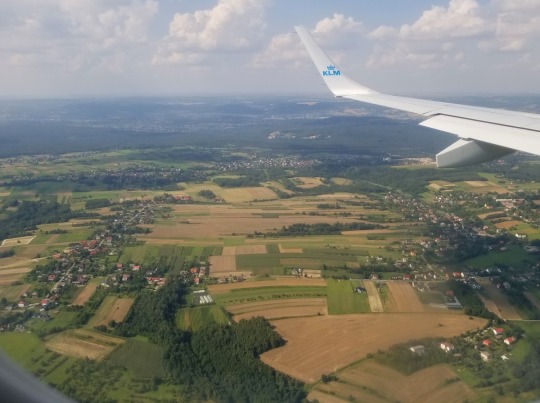
The first thing that struck me about Poland–and I noticed it from the airplane window before we even landed–was the totally unique landscape. I’ve seen forests, farmland, and urban sprawl before, but never mixed together quite so thoroughly. On the 30-minute drive from the airport into town, we passed through dense forests, low-density farmland, and a wilderness adventure park. Even in the suburban periphery of the city, apartment blocks are separated by cornfields as well as vacant lots.
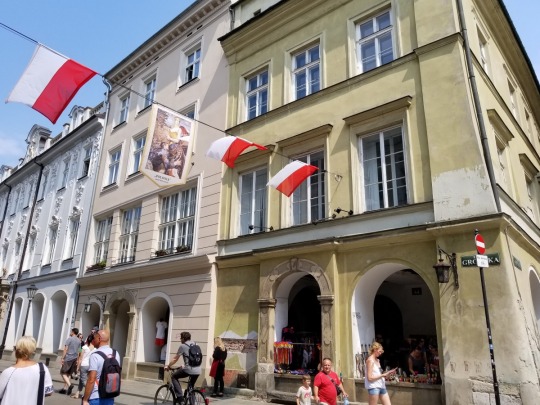
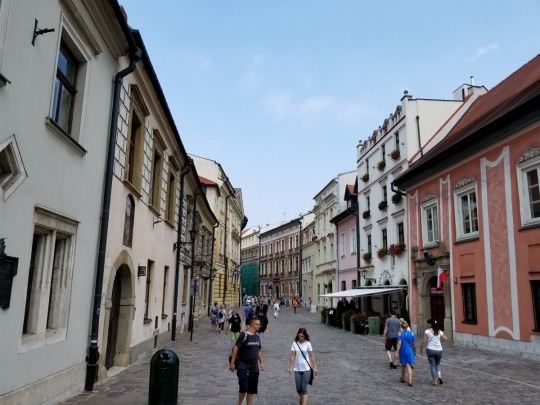

This patchwork aesthetic extends to the architecture of the old city itself. On any given street, the buildings form a mosaic that tells the long and turbulent story of Poland’s past, from the middle ages through the 21st century. Many struck me as ironically eastern European, with inward-sloping buttressed walls and steep, almost pagoda-like roofs. Others looked straight out of Renaissance Venice or Imperial Vienna. And, of course, there are the Brutalist mementos of Soviet austerity.
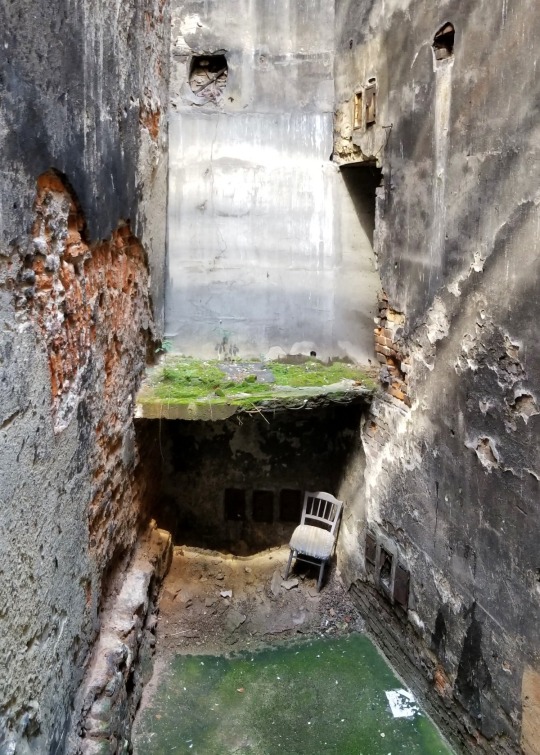
What holds it all together is a charmingly rough-around-the-edges spirit of making do with what you have. Concrete walls patched with plaster, plaster walls patched with plywood. Walking down an alleyway between two buildings, you might tread on tile, cement, and gravel all in the space of thirty yards.

But this is not a third-world country. Enter into one of these unassuming domiciles, and you might find a surprisingly luxurious abode.
Like ours.
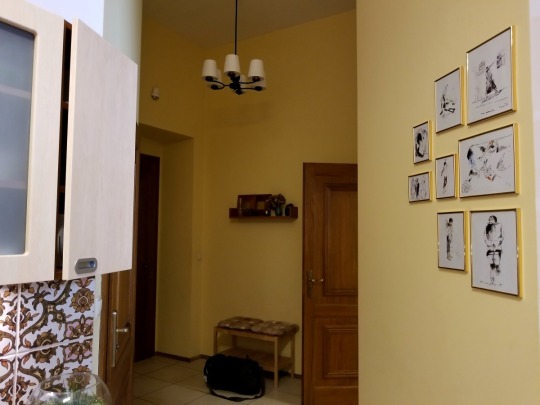

Poland is not a wealthy country. But that means that a little money can go a long way. And while you may trip on a pothole or slip on a patch of sand outdoors, you can come home to a bathtub bigger than any I’ve enjoyed in the States.
The second thing I noticed about Poland are the people. They are both the most reserved and the most outgoing people I’ve met in Europe.
Professionally and in public, everyone is just a blank face in the crowd. Our taxi driver from the airport did not make a single attempt at small talk the entire ride (not that I’m complaining!), and shopkeepers have no trouble flatly declining to assist you if you ask for something they don’t want to do.
But if you engage them personally, as a friend, guest, or tour companion, you’ll have trouble getting a word in edgewise as they talk your ears off with kind enthusiasm, sincere questions, and thoughtful advice.
Obviously, this is a stereotype and doesn’t apply to everyone in Poland. But it’s exactly what Jessica–who spent a summer here in 2010–told me to expect, and it’s exactly what I’ve experienced.
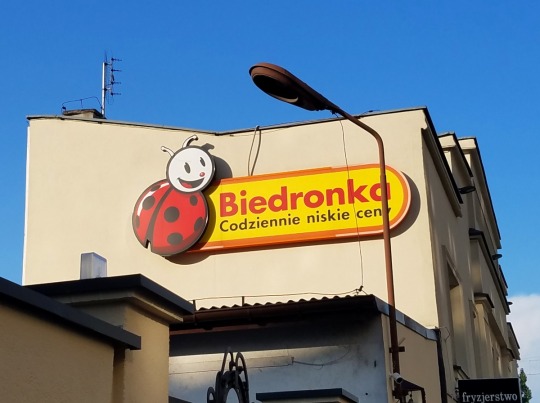
Another funny quirk is that two of Poland's biggest chain stores are named after animals. The main supermarket chain is called Biedronka, which means ladybug, and the main convenience store chain is called Zabka, which means frog.
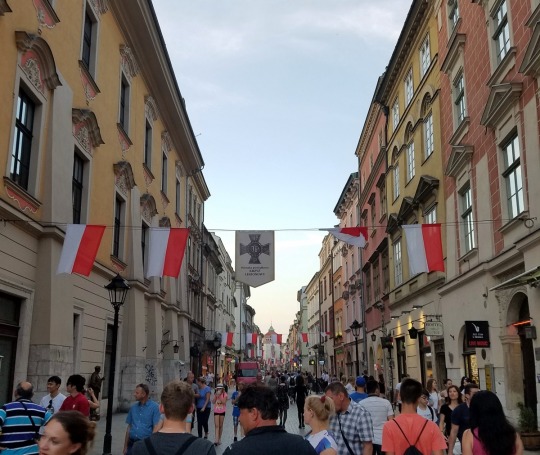
After checking into our Airbnb and stocking up on groceries, Jessica could hardly wait to take me into the old town. Rick Steves says there isn’t a better city in Europe for just wandering around in, and I can’t say I disagree.
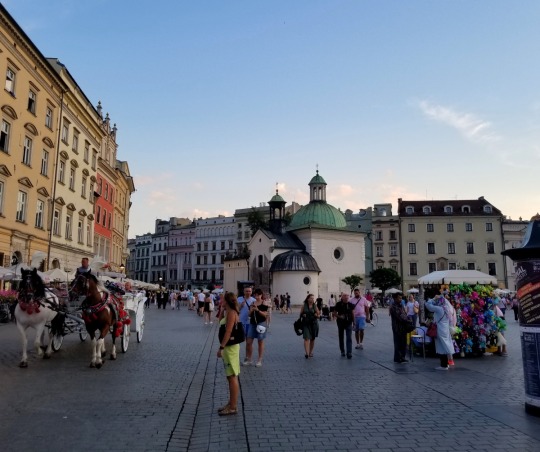
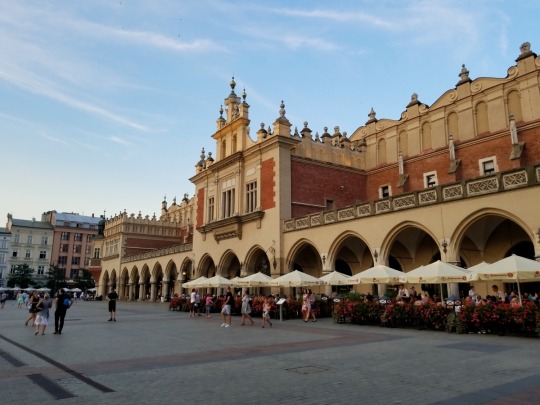
The main market square is spectacular–like Venice’s San Marco Square and Madrid’s Puerta del Sol rolled into one.
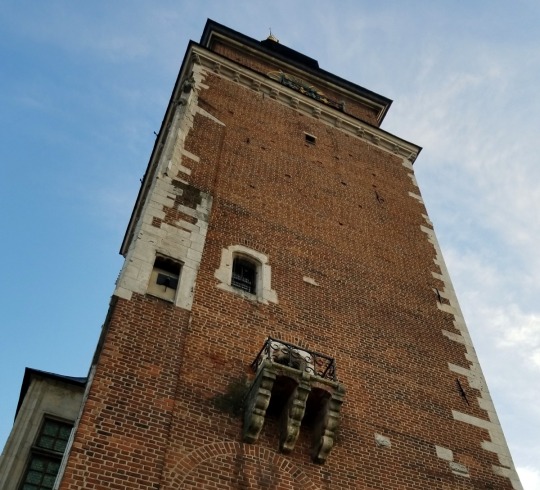
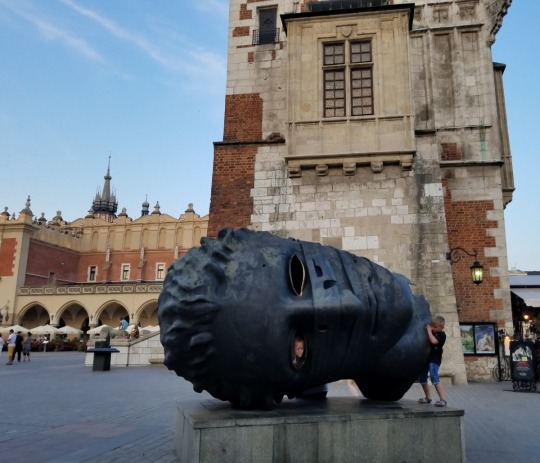
The old Renaissance merchant hall dominates the center of the square, and St. Mary’s Basilica stands proudly overlooking its northern corner.

Technically, the church only has one tower. The taller tower on the left–the one with the crown encircling its spire–is officially a city watchtower. According to legend, a 13th-century watchman was struck silent by an enemy arrow in the middle of trumpeting an alarm. Now, every hour on the hour, a trumpeter plays the same traditional anthem almost but not quite to completion in his honor.
The curtailed call is also used by the Polish national radio broadcaster, so it is a familiar sound across the country.

After taking a peek inside the market hall and up at the nearby clock tower–the remains of an otherwise-demolished medieval city hall–we meandered up the main road to the barbican gate–one of the few remaining parts of Krakow’s medieval walls.



Unlike the many European cities that turned their medieval walls into ring roads, Krakow turned their walls into a green belt surrounding the old city center. Like many Polish names, it was unintentionally amusing to us as English speakers--Planty Park.

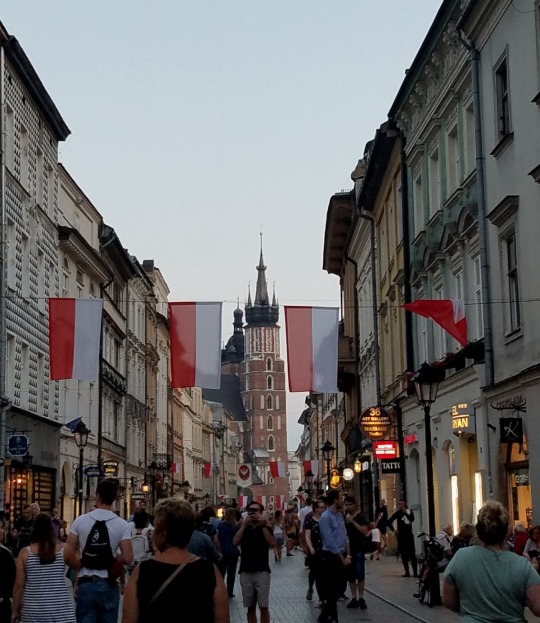
As we walked back down the main tourist drag, Jessica noted how much the place had changed in just the past eight years. A local café she'd wanted to take me to had been replaced by a Starbucks, and there were a lot more ethnic restaurants than she remembered seeing before. Though not all of them looked especially authentic.

Tired and thirsty, we headed back to our flat after stopping for drinks at a Zabka along the way. It was a warm night, but thankfully the windows were big and opened wide. As much as I had feared a culture shock, and our currency-related annoyances notwithstanding, our arrival in Poland had been surprisingly smooth. We were comfortable, well-fed, and excited to see what the city had to offer.
Next Post: Schindler’s Factory and St. Mary’s Basilica
Last Post: Resting Up (Markets, Museums, and More Pizza)
1 note
·
View note
Text
FOMA 17: A Modernist Holiday
Yerevan is a hot tourist destination for anyone with a penchant for Soviet modernism. It was robbed of its centrepiece when its Youth Palace – an ear of corn tower with a flying saucer on top for good measure – was demolished in 2006, but the city still has a great deal to offer. Much of it, however, is probably living on borrowed time.
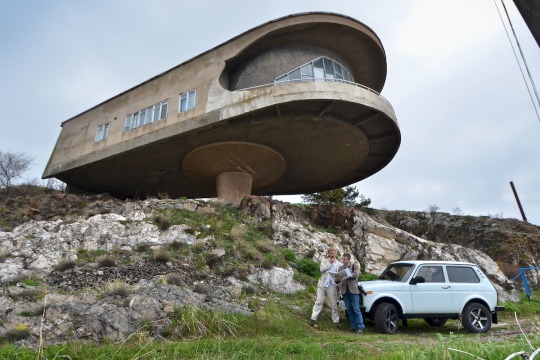
This is an account of a brief trip to Armenia in May 2015. As is my habit, I went armed with a handful of printed Google maps covered in informative scribbles.
Modernist civic architecture of the Armenian Soviet Socialist Republic was generally smaller in scale and lighter of hand than that in colder areas of the Soviet Union.

Bucking this trend is Yerevan’s aptly-named Cinema Rossiya, a gigantic and mildly sinister cantilever edifice. Its lower story now serves as a market, its rear enlarged by a mashup of UPVC conservatories and its front by a similarly distasteful modern extension.
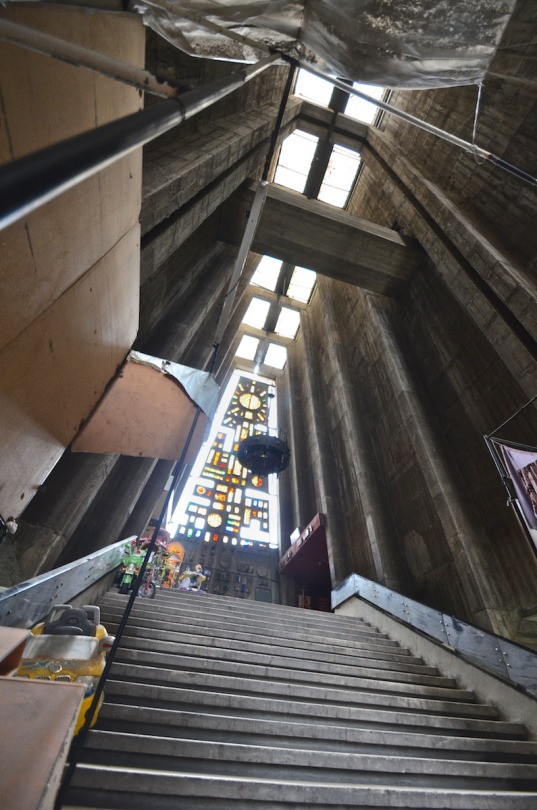
The cavernous cathedral-like hall between the two auditoria is unadulterated but borderline derelict. Our attempts to access the the auditoria were thwarted by paunchy security guards.
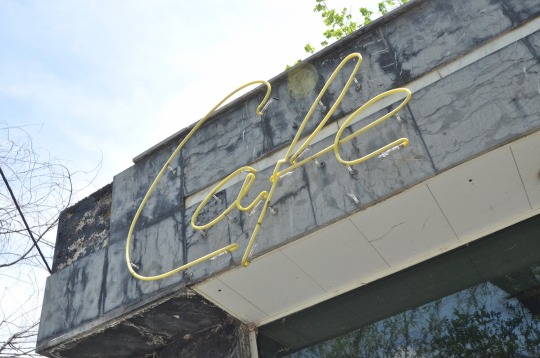
Cinema Rossiya marks the lower end of a semi-circular park that encases Yerevan’s compact centre. The park houses a handful of Soviet-era stalls and pavilions in various states of decay, some with fetching neon signage.
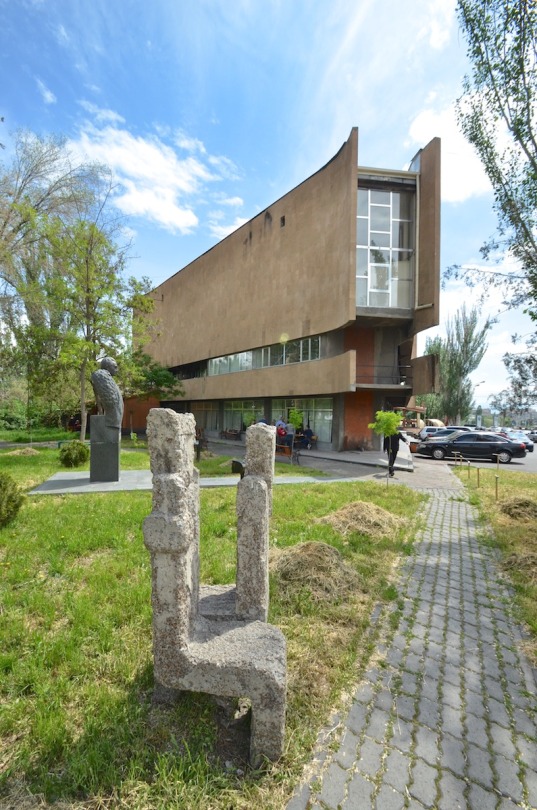
Walk around to the three ‘o clock position and you’ll find the House of Chess Players, a pretty building inside and out that’s an equilateral triangle in plan. It still supported a healthy population of chess players.

At the half-past-one position is the monolithic Komitas Chamber Music Hall, clad in deep red local tuff. It was firmly closed when we visited, posters touting upcoming events providing the only evidence that it was still in use.
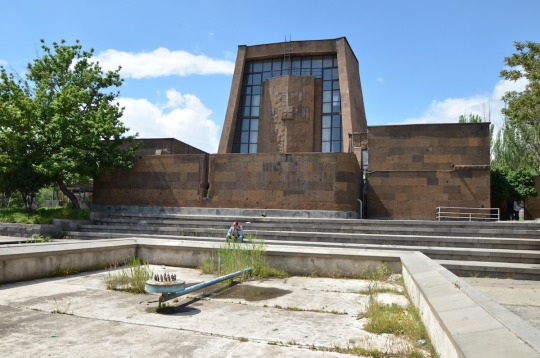
On the next ring-road out on the same tangent is a particularly grandiose example of a cable car station of the sort found throughout the Caucasus. It’s derelict, but its flying saucer shell remains intact and a solitary cable car still hangs at the rear.

At the park’s one ‘o clock position is Yeritasardakan Metro Station, a bizarre construction with a circular light shaft above its entrance hall that sprouts from the ground at a 30° angle like the barrel of a giant mortar.

The Metro is a handsome but nondescript stock Soviet system. From the escalator downward, you could be anywhere between here and St Petersburg.
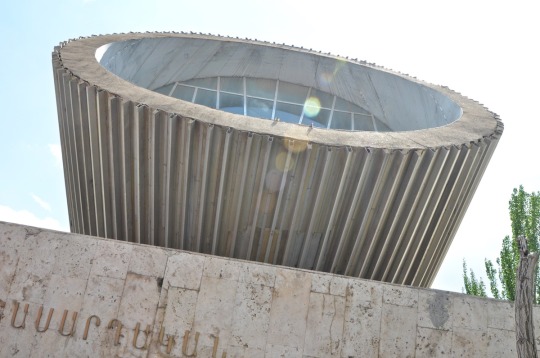
At twelve ‘o clock is the much-photographed Yerevan Cascade, an impressive limestone stairway punctuated by ornate fountains, monuments and some quite weird sculptures. Climbing to the top is vaguely anticlimactic.

The view is reasonable, but it’s nothing compared to that from the mammoth Karen Demirchyan Sports and Concert Complex, a giant sci-fi bunker perched on a hilltop a few kilometers west of the city centre. Despite the addition of tasteless steel cladding and low-grade glazing, the scale and sweeping form of the building remain striking.


The centre of Yerevan boasts a number of other modernist buildings of note – and there are various others in the vicinity that I didn’t have time to visit. It’s definitely worth scheduling a few days if you can. It’s generally a nice place to spend time. Ararat brandy is excellent and Kilikia beer adequate.

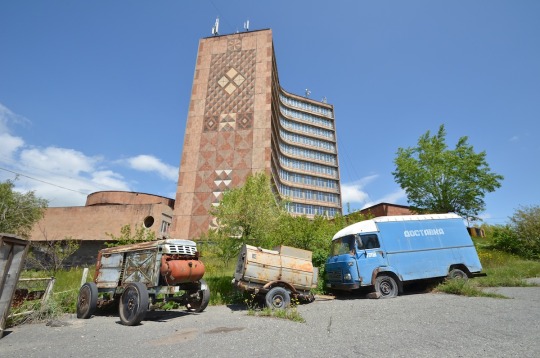
Leaving the city in a northeasterly direction, you’ll pass the former Institute of Stones and Silicates – a shapely three-pronged office block adorned with tilework that showcases Armenia’s colourful palette of volcanic stone. A little further on is the Northern Bus Station.

On the outside it’s a confusion of crumbling red tiles and unkept foliage. In the inside, however, it’s an airy and elegant palace of sweeping staircases and balconies clad in polished stone. Beautiful as it is, its purpose is a puzzle.

It now houses a solitary ticket booth and a terminally closed café, but it’s hard to imagine that much else has ever happened there. The second floor sports a solitary RAF Latvia minibus perched above a treacherous spiral staircase that’s either had its balustrade stolen, or it never had one in the first place.
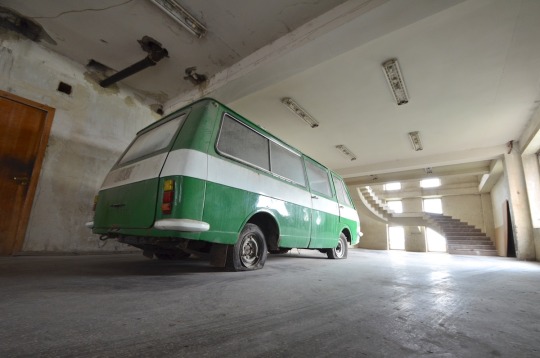
Nearby, incidentally, is the remarkable Levon’s Divine Underground (5th street, 9th house Arinj, Kotayk to be exact). Local builder Levon Arakelyan started digging a cellar beneath his small suburban house in 1985.

Two decades later, he’d excavated a 300-square metre labyrinth. It’s a work of solitary human obsession that a rivals any Werner Herzog film. Levon sadly passed away in 2008, but his wife, Tosya, will give an enthusiastic tour for a small fee if you knock on the door and she’s not busy.
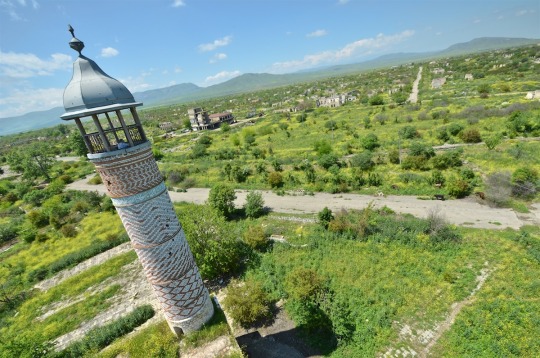
We hired a Lada and drove to Nagorno-Karabakh, a self-declared and much-disputed autonomous republic within the borders of Azerbaijan. Its Ruritanian and mafia-rich capital Stepanakert was culturally fascinating, but we found little of architectural note. There are a few grand Soviet monuments dotted around the countryside.
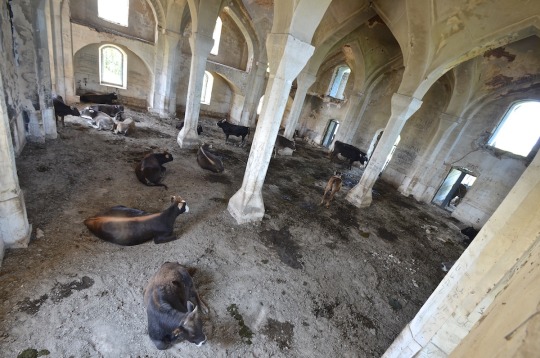
The ghost town of Agdam – raised during the Nagorno-Karabakh war in the 1990s – houses a solitary stone mosque. Once a fine example of 19th Century Karabakh architecture, it’s now in a very sad state and filled with cattle.
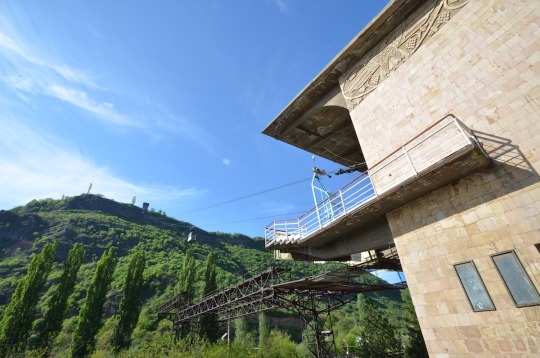
On the way back to Yerevan we visited Alaverdi, a grim copper-mining town that sustains one of the few Caucasian cable cars that’s still in working order. The ride was picturesque, if a little terrifying.
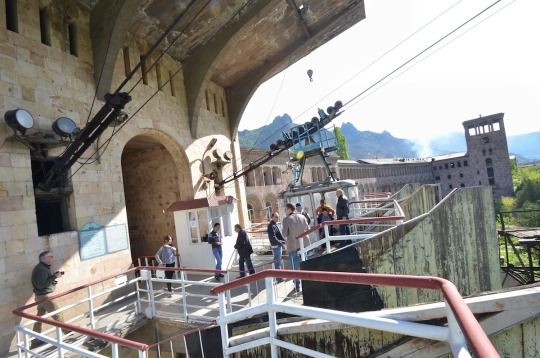
Next, we swung by Sevan to inspect the canteen of the Armenian Writers' Union – best known as the cover shot of the excellent book Soviet Modernism 1955-1991: An Unknown History (find the review here).

It was as striking and otherworldly as anticipated. Photographs don’t do justice to its location. It hovers high and lonely on a rocky hillside, its 180° window offering a bleak panoramic view of Lake Sevan.

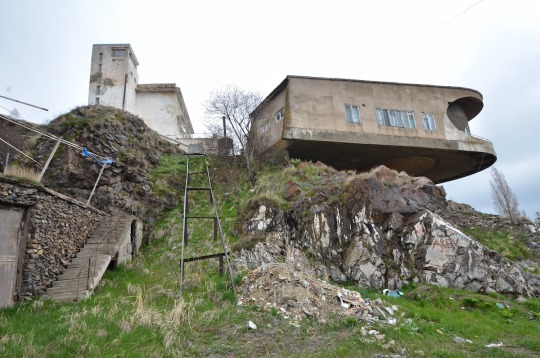
The best came last. Unless you travel overland from Georgia, it’s more-or-less impossible to visit Armenia without passing through Zvartnots International Airport.
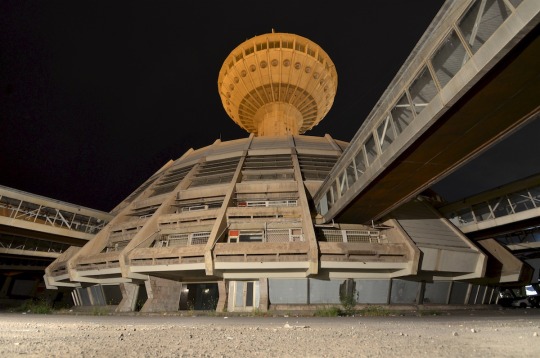
The new Terminal 2 (2006) is pleasant enough, but forgettably generic. The old Terminal 1 (1971), closed since 2011, is enormously exciting. It’s a space-age concrete fantasia.
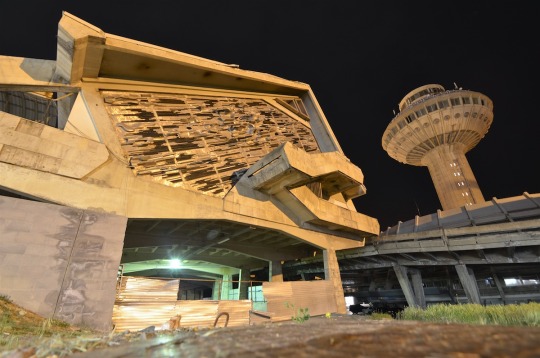
A flying saucer control tower sprouts from a rotund central check-in area, orbited by a ring of departure lounges connected by flying walkways. It was totally abandoned when I visited in the early hours of the morning, save for a few security guards who did a fine job of pretending I was invisible.
I spent two very happy hours wandering around unhindered and admiring its many thoughtful intricacies. Few buildings demonstrate so spectacularly what a disappointment the future has turned out to be.

I suspect that security has now been heightened. If it hasn’t, I’d urge anyone that finds themselves in the vicinity to go and have a poke around. Like most modernist architecture in Armenia, I fear its days are numbered.
___
#FOMA 17: Sam Glover
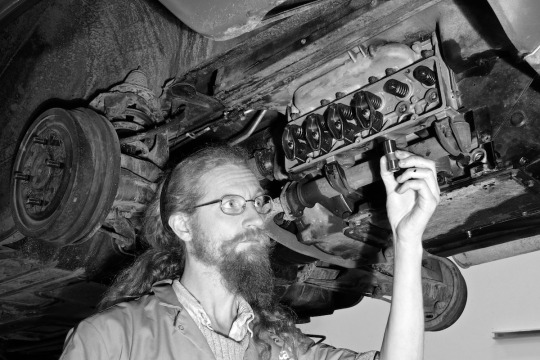
Sam Glover is a writer and engineer from the United Kingdom with a penchant for exploring remote parts of eastern Europe and the former Soviet Union. In his project Soviet Modernism, he aims to visit and document as much socialist modernist and constructivist architecture as he can before it’s defaced, demolished or improved. He is technical editor of Practical Classics magazine and specialises in the restoration of unusual classic cars. He has a First Class Honours degree in Design from the University of Sunderland.
217 notes
·
View notes
Text
Sandblast Nozzle Market Key Companies and Analysis Top Trends by 2030
Global Sandblast Nozzle Market – Overview
Sandblasting nozzles are an important part of sandblasting machines. These nozzles enable in accelerating the air and abrasive as the mixture exits the end of the hose. The nozzle allows to dispense the abrasive and controls the flow by directing it against a surface to remove the contaminants and smoothing down a rough surface. Due to the ever-growing construction industry in developing regions, the sandblasting nozzle manufacturers are finding ways to improve the design of nozzles in order to increase productivity and efficiency. Focusing on the safety of operator and as per the guidelines by OSHA (Occupational Safety and Health Administration), the manufacturers are integrating the machines with remote controls. This will allow the blast operator to start and stop the machine at the nozzle itself, in return creating the demand for sandblasting nozzle. Owing to the above-mentioned facts, the global market for sandblast nozzle is anticipated to grow at a significant rate over the forecast period 2020-2030.
Download PDF Brochure: https://www.tmrresearch.com/sample/sample?flag=B&rep_id=6560
In the current scenario, the outbreak of COVID-19 has negatively impacted the multiple end-use industries like automotive, construction, marine, and aerospace to name a few due to the statewide lockdowns. Thus, it is foreseen to show a slow growth of sandblast nozzle market in the near future.
Global Sandblast Nozzle Market – Dynamics
The rising usage of sandblast machines in industrial applications, particularly in automotive, marine, and construction industry is driving the demand for sandblast nozzle market. Furthermore, the broad range of applications by sandblast nozzle such as surface texturing of concrete and removal of rust from metallic and non-metallic surfaces will likely boost the sales of sandblast nozzle. However, the high cost associated with the repair and maintenance of nozzle coupled with the replacement of nozzles may hinder the growth of market. In addition, the automotive industry is anticipated to create substantial opportunities for sandblast nozzle manufacturers as they are highly utilized in polishing and surface finishing activities in vehicle manufacturing. Owing to the points mentioned above, remarkable prospects in the production of sandblast nozzle is foreseen for market players during the forecast period 2020-2030.
Global Sandblast Nozzle Market – Regional Analysis
The global sandblast nozzle market is split into seven geographical regions: North America, Europe, Latin America, South Asia which includes India, Thailand, Indonesia, Malaysia, Philippines, Rest of South Asia, Middle East & Africa, and East Asia, which further includes China, Japan and South Korea. The sandblast nozzle market for Oceania incorporates Australia & New Zealand. Asia-Pacific to dominate the global sandblast nozzle market. Owing to the increasing manufacturing and construction activity in emerging countries like India, China are expected to boost the sales of sandblast nozzle. North America market for sandblast nozzle market is also projected to show significant growth. Countries in Europe, Middle East & Africa are forecasted to be slightly behind in the demand for sandblast nozzle market.
Global Sandblast Nozzle Market Segments:
For a better understanding, the global Sandblast Nozzle market is being studied under product type, size, material and end use industries.
By Product Type, Global Sandblast Nozzle Market is Segmented as:-
Venturi Nozzle
Straight Bore Nozzle
Double Venturi Nozzle
Wide Throat Nozzle
Others
By Size, Global Sandblast Nozzle Market is Segmented as:-
3/8 Inches
7/16 Inches
1/2 Inches
5/8 Inches
3/4 Inches
By Materia, Global Sandblast Nozzle Market is Segmented as:-
Tungsten Carbide
Ceramic
Boron Carbide
By End Use Industries, Global Sandblast Nozzle Market is Segmented as:-
Automotive
Marine
Aerospace
Construction
Metalworking
Sandblast Nozzle Market – Manufacturers
The global sandblast nozzle market includes both regional and global level manufacturers such as Everblast, Starblast Abrasives, Somax, Manus Abrasive Systems, Burwell Technologies, Airblast B.V., MHG Strahlanlagen GmbH, Clemco International, are the prominent players with significant market share globally.
The research report presents a comprehensive assessment of the Sandblast Nozzle market, and contains thoughtful insights, facts, historical data, and statistically supported and industry-validated data. It also contains projections using a suitable set of assumptions and methodologies. The Sandblast Nozzle market report provides analysis and information according to market segments such as product type, size, material, and end use industries.
The Sandblast Nozzle market Report Covers Exhaustive Analysis On:
Market Segments in the Sandblast Nozzle market
Sandblast Nozzle market Dynamics
Sandblast Nozzle market Size
Supply & Demand
Current Trends/Issues/Challenges
Competition & Companies Involved
Technology in the Sandblast Nozzle market
Value Chain of the Sandblast Nozzle market
The Sandblast Nozzle market report is a compilation of first-hand information, qualitative and quantitative assessment by industry analysts, and inputs from industry experts and industry participants across the value chain. The Sandblast Nozzle market report provides an in-depth analysis of parent market trends, macroeconomic indicators, and governing factors, along with market attractiveness as per segment. The Sandblast Nozzle market report also maps the qualitative impact of various market factors on market segments and geographies.
Report Highlights:
Detailed overview of the parent market
Changing Sandblast Nozzle market dynamics in the industry
In-depth Sandblast Nozzle market segmentation
Historical, current, and projected market size in terms of volume and value
Recent industry trends and developments
Competitive landscape
Strategies of players and products offered
Potential and niche segments, geographical regions exhibiting promising growth
A neutral perspective on market performance
Must-have information for market players to sustain and enhance their market footprint.
Key questions answered in this report
What are the diverse growth parameters influencing the market?
Which regions will contribute largely to the growth of the market
What are the recent innovations and technological advancements in the market?
What are the emerging trends across the market?
How has COVID-19 affected the market?
What will be the post-pandemic scenario of the market?
What are the major threats that will dent the growth prospects of the market?
About Us:
TMR Research is a premier provider of customized market research and consulting services to business entities keen on succeeding in today’s supercharged economic climate. Armed with an experienced, dedicated, and dynamic team of analysts, we are redefining the way our clients’ conduct business by providing them with authoritative and trusted research studies in tune with the latest methodologies and market trends.
Contact Us:
Rohit Bhisey
Head Internet Marketing
Tel: +1-415-520-1050
Website: https://www.tmrresearch.com/
0 notes
Text
Europe Non-Residential Polished Concrete Market Revenue to Surpass USD 1.9 Billion by 2027
In terms of revenue, Europe non-residential polished concrete market is forecast to surpass USD 1.9 billion by 2027. Gradual growth in the construction sector and the subsequent market uptake of polished concrete have fueled Europe non-residential polished concrete market value. With the demand for remodeling and restoration projects soaring, governments have introduced robust policies to ease the entry of new players.
The polished concrete portfolio has gained uptick in the light of availability of various patterns, colors and high reflective characteristics. The innate ability to improve the environment lighting boosts the aesthetic appeal of polished concrete and helps reduce the energy bill.
Get sample copy of this research report @ https://www.graphicalresearch.com/request/1700/sample
Considering the demand from commercial buildings, polished concretes have become highly sought-after in the commercial sector. An unprecedented rise in hotel construction activities has augured well for the industry size expansion. It is worth noting that the hotel construction projects are expanding at a 10% annual growth rate in the region.

With renovation activities gaining traction in restaurants & hotels in the U.K., Germany, Denmark and France, demand for polished concretes is likely to surge in commercial spaces. The Europe non-residential polished concrete market share from the commercial segment in Europe logged around 45.9% and will grow at a 4.8% CAGR through 2027.
A notable rise in manufacturing facilities, medical centers, superstores and retail stores has further stimulated the demand for polished concretes in the region. Industry participants are infusing funds in the healthcare sector and educational facilities to gain a competitive edge in the landscape.
The dynamics of polished concrete is likely to be noticeable in new floors. Robust demand for new flooring applications is majorly attributed to superior aesthetics, cost-effectiveness and traction from infrastructure and commercial projects.
It is worth noting that low maintenance costs of polished concrete vis-à-vis other flooring options have made the flooring application trendier among the end-users. The Europe non-residential polished concrete market share from the new floors segment stood at over 80% in 2020 and will grow owing to enhanced aesthetics, high light reflectivity and ease of cleaning attributes.
Europe non-residential polished concrete market outlook will continue to remain bullish on account of investments galore in countries such as Germany and the U.K. More importantly, stakeholders are poised to inject funds in Germany in the light of rise in the number of aging buildings. Renovation activities are likely to remain instrumental in EU. According to the European Parliament, approximately 35% of buildings are over 50 years old in the European Union.
With construction industry being pegged at about 9% of Europe’s GDP, stakeholders are poised to infuse funds in the polished concrete market. That said, carbon emission will potentially impel the Europe non-residential polished concrete market growth. According to the National Ready Mixed Concrete Association (NRMCA), around 0.93 kg of carbon stems for every kg of polished concrete. Moreover, the COVID-19 fallout is likely to impede non-residential polished market outlook in Europe.
Market participants are adopting robust business strategies, including mergers & acquisitions, new product launches and product portfolio expansion to stay ahead of the curve in the landscape. For instance, HeidelbergCement Group plans to reorganize the production facilities in France with around USD 400 million in funds. The plant is said to include conversion of plants and automated cement terminals.
Request for customization @ https://www.graphicalresearch.com/request/1700/customize-this-report
Some of the leading companies in the industry are Polished Concrete Co., Vicat SA, Breedon Group plc, CRH plc, Concria, ELKON and MIKEA.
Table of Contents (ToC) of the report:
Chapter 1 Methodology & Scope
1.1 Research Methodology
1.2 Market estimation & forecast parameters
1.3 List of Data sources
1.3.1 Primary
1.3.2 Secondary
Chapter 2 Executive Summary
2.1 Europe Non-Residential Polished Concrete market snapshot
Chapter 3 Europe Non-Residential Polished Concrete Industry Insights
3.1 Industry coverage
3.2 Industry size and forecast, 2017 – 2027
3.3 Industry ecosystem analysis
3.3.1 Vendor matrix
3.4 Future trends
3.4.1 Innovation Landscape
3.5 Raw material analysis
3.6 Regulatory norms & directives
3.7 Drivers & restraints
3.7.1 Drivers
3.7.2 Restraints
3.8 Application growth mapping
3.9 Industry analysis: Porter’s
3.10 Competitive benchmarking
3.10.1 Strategy dashboard
3.11 PEST analysis
Browse complete Table of Contents (ToC) of this research report @ https://www.graphicalresearch.com/table-of-content/1700/europe-non-residential-polished-concrete-market
About Graphical Research:
Graphical Research is a business research firm that provides industry insights, market forecast and strategic inputs through granular research reports and advisory services. We publish targeted research reports with an aim to address varied customer needs, from market penetration and entry strategies to portfolio management and strategic outlook. We understand that business requirements are unique: our syndicate reports are designed to ensure relevance for industry participants across the value chain. We also provide custom reports that are tailored to the exact needs of the customer, with dedicated analyst support across the purchase lifecycle.
Contact Us:
Parikhit B.
Corporate Sales,
Graphical Research
Phone: 1-800-986-6917
Email: [email protected]
Web: https://www.graphicalresearch.com
#Europe Non-Residential Polished Concrete Market Analysis#Europe Non-Residential Polished Concrete Market by Type#Europe Non-Residential Polished Concrete Market Share#Europe Non-Residential Polished Concrete Market Development
0 notes
Text
Rare earth metals at the heart of China's rivalry with US, Europe
A picture taken in 2012 reveals a rare earth refinery near Baotou, China, the nation controling the international mining and refining of the minerals.
What if China were to cut off the United States and Europe from access to rare minerals that are vital to electrical cars, wind turbines and drones?
At a time of regular geopolitical friction amongst those 3 powers, Washington and Brussels wish to prevent this circumstance by buying the market for 17 minerals with distinct residential or commercial properties that today are mainly drawn out and improved in China.
“The expected exponential growth in demand for minerals that are linked to clean energy is putting more pressure on US and Europe to take a closer look at where the vulnerabilities are and the concrete steps these governments can take,” stated Jane Nakano, a senior fellow at the Washington-based Center for Strategic and International Studies.
In 2019, the United States imported 80 percent of its rare earth minerals from China, the US Geological Survey states.
The European Union gets 98 percent of its supply from China, the European Commission stated in 2015.
Amid the shift to green energy in which rare earth minerals make certain to contribute, China’s market supremacy suffices to sound an alarm in western capitals.
Cars and turbines
Rare earth minerals with names like neodymium, praseodymium and dysprosium are essential to the manufacture of magnets utilized in markets of the future like wind turbines and electrical cars and trucks. And they are currently present in durable goods such as smart devices, computer system screens and telescopic lenses.
Others have more conventional usages, like cerium for glass polishing and lanthanum for vehicle drivers or optical lenses.
This week the US Senate passed a law intended at enhancing American competitiveness that consists of arrangements to enhance crucial minerals supply chains, following a comparable executive order released by President Joe Biden in February.
Washington intends to increase production and processing of rare earths and lithium, another essential mineral element, while “working with allies and partners to increase sustainable global supply and reduce reliance on geopolitical competitors,” Deputy Director of the National Economic Council Sameera Fazili stated Tuesday.
Boosting US production
The finest wish for improving American production can be discovered at the Mountain Pass mine in California.
Once one of the significant gamers in the sector, the my own suffered as China increased and consumed its market share, helped by Beijing’s heavy federal government aids.
MP Materials relaunched the mine in 2017 and intends to make it a sign of America’s commercial renewal, stating the concentration of rare earths at its website is one of the world’s biggest and highest-grade rare earth deposits, with soil concentrations of 7 percent versus 0.1 to 4 percent in other places.
The business’s goal is to separate rare earth minerals from each other by means of a chemical procedure, and after that by 2025 manufacture the magnets that market utilizes—as market-leading Chinese companies presently do.
The job was supported by the US federal government, while a Chinese company is a minority investor.
Elsewhere, Australian business Lynas has actually won numerous agreements in the United States, consisting of an ore refinery in Texas for the military that was supported by the Defense Department.
Complications for Europe
In Europe, Bernd Schafer, CEO and Managing Director of rare earth mineral consortium Eit Raw Materials, stated this month that an “action plan” will quickly exist to the European Commission on how to increase production.
Europe, nevertheless, deals with a more complex course to attaining this objective, stated David Merriman, an expert in batteries and electrical cars and trucks for London-based consultancy Roskill.
“Europe is expected to rely on importing raw materials or semi-processed materials and become more a processing base or recycling base,” he stated.
China is anticipated to stay dominant for a long time to come, however Schafer stated that if recycling is scaled up, “20 to 30 percent of Europe’s rare earth magnet needs by 2030 could be sourced domestically in the EU from literally zero today.”
The desire to speed up rare earth production comes amidst a lack of semiconductors, which are important for the computing and automobile markets and mainly made in Asia.
The shortage “has caused global manufacturers to think about their supply chain in a new way, and think about vulnerabilities,” a spokesperson for MP Materials stated, including that numerous European automobile and wind power companies are currently in contact with the business.
Biden’s wishes for rare earth self-reliance at least a years away
© 2021 AFP
Citation:
Rare earth metals at the heart of China’s rivalry with US, Europe (2021, June 13)
recovered 13 June 2021
from https://techxplore.com/news/2021-06-rare-earth-metals-heart-china.html
This file undergoes copyright. Apart from any reasonable dealing for the function of personal research study or research study, no
part might be recreated without the composed authorization. The material is attended to details functions just.
New post published on: https://livescience.tech/2021/06/13/rare-earth-metals-at-the-heart-of-chinas-rivalry-with-us-europe/
0 notes
Text
Decorative Concrete Market Statistics, Business Opportunities, Competitive Landscape and Industry Analysis Report by 2028
The Global Decorative Concrete Market Report offers extensive knowledge and information about the Electric Automotive Composites market pertaining to market size, market share, growth influencing factors, opportunities, and current and emerging trends. The report is formulated with the updated and latest information of the Decorative Concrete market further validated and verified by the industry experts and professionals. The Decorative Concrete Market report contains historical, current, and forecast estimation of the revenue generation and profits for each segment and sub-segment of the Automotive Composites market in each key region of the world. The report additionally sheds light on the emerging growth opportunities in the business sphere that are anticipated to bolster the growth of the market.
The global decorative concrete market is expected to reach a market size of USD 26.99 Billion at a steady CAGR of 6.1% in 2028, according to latest analysis by Emergen Research. The decorative concrete market is witnessing increased demand due to the rising trend of remodeling and renovation to improve aesthetics of outdoor and indoor structures in residential and non-residential sectors. Increase in household and commercial spending and shift in consumer preference towards enhancement of aesthetic appeal of such structures is projected to drive growth of the decorative concrete market. Decorative concrete is low maintenance and offers high durability and reliability, which is driving rising demand and growth of the market.
Get a sample of the report @ https://www.emergenresearch.com/industry-report/decorative-concrete-market
Competitive Landscape:
The latest report encases an in-depth summary of the intensely competitive landscape of the Decorative Concrete market, with systematic profiling of the companies operating across this industry. In this section of the report, experts have listed down the strategic initiatives undertaken by these market rivals for proposed business expansion. Additionally, it highlights the key developments and financial positions of these companies to explain the overall market scenario. The company profiles of the established and new players have also been assessed in the report through effective analytical tools like SWOT analysis.
Key players in the market include 3M Company, BASF SE, PPG Industries, Inc., DuPont, Arkema S.A., Ultratech Cement Limited, The Sherwin Williams Company, Huntsman International LLC, Boral Limited, and Sika AG.
The complete regional analysis covers:
North America (U.S., Canada, Mexico)
Europe (U.K., Italy, Germany, France, Rest of EU)
Asia Pacific (India, Japan, China, South Korea, Australia, Rest of APAC)
Latin America (Chile, Brazil, Argentina, Rest of Latin America)
Middle East & Africa (Saudi Arabia, U.A.E., South Africa, Rest of MEA)
Emergen Research has segmented the global decorative concrete market on the basis of type, application, end-use, and region:
Type Outlook (Revenue, USD Billion; 2021–2028)
Stained Concrete
Colored Concrete
Stamped Concrete
Epoxy Concrete
Polished Concrete
Concrete overlays
Application Outlook (Revenue, USD Billion; 2021–2028)
Walls
Floors
Pool Decks
Driveways & Sidewalks
Patios
End-use Outlook (Revenue, USD Billion; 2021–2028)
Residential
Non-residential
Thank you for reading our report. Customization of the report is available. To know more, please connect with us, and our team will ensure the report is customized as per your requirements.
Take a Look at our Related Reports:
Wound Care Market
Greenhouse Film Market
Drug Screening Market
Mice Model Market
Green Mining Market
About Us:
At Emergen Research, we believe in advancing with technology. We are a growing market research and strategy consulting company with an exhaustive knowledge base of cutting-edge and potentially market-disrupting technologies that are predicted to become more prevalent in the coming decade.
0 notes
Text
Polished Concrete Market Insights on Scope and Growing Demands 2027
Polished Concrete Market Overview:
Maximize Market Research (MMR) spent a lot of time and effort investigating the global Polished Concrete Market, focusing on each sector while considering global and regional trends. In order to create a balanced market environment, the primary drivers as well as significant restraints have been thoroughly addressed. To give readers a complete picture of the market, the research separates it into several areas, including Product, Application, Retailers, and Regions. The research also includes long-term industry estimates for the global Polished Concrete Market.
Request for free sample:
https://www.maximizemarketresearch.com/request-sample/90811
Market Scope:
The global Polished Concrete market is expected to develop at a steady rate between 2021 and 2027, according to the forecast. Between 2021 and 2027, the industry is expected to grow rapidly, with leading market players putting in significant effort.
The development process is examined, as well as cost structures and development goals and objectives. This global Polished Concrete market report covers import/export consumption, supply and demand, cost, price, share, sales volume, revenue, and gross margins. In the global Polished Concrete market, this study looks at each producer's manufacturing sites, capacity, production, ex-factory price, market price, sales revenue, and market share. Among the countries (regions) are the United States, Canada, Mexico, Germany, France, the United Kingdom (UK), Russia, Italy, China, Japan, Korea, India, Southeast Asia, Australia, Brazil, and Saudi Arabia.
Get more Report Details
https://www.maximizemarketresearch.com/market-report/global-polished-concrete-market/90811/
Drivers:
Polished Concretes are water-resistant, dust resistant, and snow resistant but are permeable to air. The membrane is located on the cold side of the insulation. To prevent moisture that may have been getting through the external covering from penetrating further into the structure.
Segmentation:
By Type, the segment is bifurcated into Polyethylene, Polypropylene. Polyethylene Polished Concrete is dominating the type segment of the Polished Concrete market. The major driving factor of polyethylene Polished Concrete is their ability to pass gases but not water so the membrane can be used as waterproof material with moisture resistance. Additionally, the cost benefits of polyethylene Polished Concrete are advantageous as compared to non-Polished Concrete products.
Key Players:
• BRP Manufacturing
• Canam Group Inc.
• Cosmec Inc.
• D.S. Brown
• DOSHIN RUBBER PRODUCTS (M) SDN. BHD.
• Ekspan Limited
• Freyssinet Limited
• Granor Rubber & Engineering Pty. Limited
• MAURER SE
• AFTC
• Ningbo Dragon Packaging Technology Co., Ltd.
• Rollprint Packaging Products, Inc.
Regional Analysis:
The global Polished Concrete market is split up into five regions: Europe, North America, Asia-Pacific, the Middle East and Africa, and Latin America.
COVID-19 Impact Analysis on Polished Concrete Market:
The COVID-19 Pandemic has the potential to disrupt global markets in three ways: by directly affecting production and demand, disrupting supply networks and marketplaces, and bankrupting businesses and financial institutions. The purpose of this research is to understand more about the current situation, the economic slump, and COVID-19's impact on the global Polished Concrete market.
Key Questions answered in the Polished Concrete Market Report are:
· Which product segment grabbed the largest share in the Polished Concrete market?
· How is the competitive scenario of the Polished Concrete market?
· Which are the key factors aiding the Polished Concrete market growth?
· Which region holds the maximum share in the Polished Concrete market?
· What will be the CAGR of the Polished Concrete market during the forecast period?
· Which application segment emerged as the leading segment in the Polished Concrete market?
· Which are the prominent players in the Polished Concrete market?
· What key trends are likely to emerge in the Polished Concrete market in the coming years?
· What will be the Polished Concrete market size by 2027?
· Which company held the largest share in the Polished Concrete market?
About Us:
Maximize Market Research provides B2B and B2C research on 12000 high growth emerging opportunities & technologies as well as threats to the companies across the Healthcare, Pharmaceuticals, Electronics & Communications, Internet of Things, Food and Beverages, Aerospace and Defence and other manufacturing sectors.
Contact Us:
MAXIMIZE MARKET RESEARCH PVT. LTD.
3rd Floor, Navale IT Park Phase 2,
Pune Bangalore Highway,
Narhe, Pune, Maharashtra 411041, India.
Email: [email protected]
Phone No.: +91 20 6630 3320
Website: www.maximizemarketresearch.com
0 notes